Iraq Travel Guide
This is an Iraq Travel Guide from taste2travel.com
Date Visited: August 2022
Introduction
For the past few decades Iraq has been in the news headlines for all the wrong reasons. From the Iran-Iraq war during the 80’s, the 1st Gulf War during the 90’s, the 2nd Gulf War in the 2000’s, then Al-Qaeda and ISIS in later years, the news cycle has always been negative and shocking!

Worshippers at the Al-Askari Shrine in Samarra.
While things have settled down considerably, Iraq is far from being a mainstream holiday destination. Most government websites which issue travel advisories (always overly cautious) advise against any sort of travel to Iraq.

Detail of the marble, winged-bull Lamassus at the Iraq Museum.
The United States government has placed Iraq on its list of banned countries for the purposes of travel using ESTA. This affects non-US passport holders who would normally enter the US using an ESTA. If you visit Iraq, you forfeit your right to enter the US using an ESTA. Instead, you will need to apply for a Tourist Visa from a US Embassy (see the ‘Visa Requirements‘ section below for more details).

A copper shop in the Al-Safafeer souk, Baghdad.
Up until March of 2021, obtaining a visa to visit Federal Iraq (i.e. the main part of Iraq which is separate to the autonomous region of Iraqi Kurdistan) was very difficult.

Once named one of the most beautiful monuments in the Middle East, Martyrs Monument features a 40-m tall split turquoise dome.
That changed following a visit to Iraq by His Holiness Pope Francis from the 5th to 8th of March. After visiting several historical sights, the Pope, who was clearly impressed by what he had seen, commented that all of humanity should be free to come to Iraq to view the many splendid sights which can be found within the country.

A highlight of the abandoned Al-Ukhaidir Fortress, near Karbala, are the decorated arches of the former mosque portico.
Just a week later, on the 15th of March 2021, the Iraqi government lifted pre-arrival visa requirements for citizens from 37 countries, allowing citizens from those countries to apply for a visa-on-arrival (VOA) at approved land, sea and air border crossings. More details on the VOA can be found in the ‘Visa Requirements‘ section below.

Al-Askari Shrine is one of many dazzling Shia shrines which can be visited in Iraq.
Despite its recent turmoil, Iraq has an illustrious and glorious history. Modern Iraq started life as the ancient civilisation of Mesopotamia, where the world’s earliest civilisation developed. The name comes from a Greek word meaning “between rivers,” referring to the land between the Tigris and Euphrates rivers.

Al-Ukhaidir Fortress – a photographer’s dream.
The fabled city of Babylon, which was built on the banks of the Euphrates River, lies one hour south of modern Baghdad and is again open to tourists.
Apart from its wealth of ancient history, Iraq is home to the holiest sites for Shi’ite Muslims, with the most ornate and dazzling shrines open for all to visit. The holy shrines are located in the cities of Karbala, Najaf and Samarra and are truly special places to visit.

A shop in Baghdad souk.
It’s as close to Mecca as a non-Muslim can get. I was always made to feel welcome when visiting these most sacred of places.
Like their brothers in Iraqi Kurdistan, the Iraqis of Federal Iraq are some of the kindest, nicest, most welcoming people a traveller could ever hope to meet. Never did I feel threatened or unsafe in Iraq.
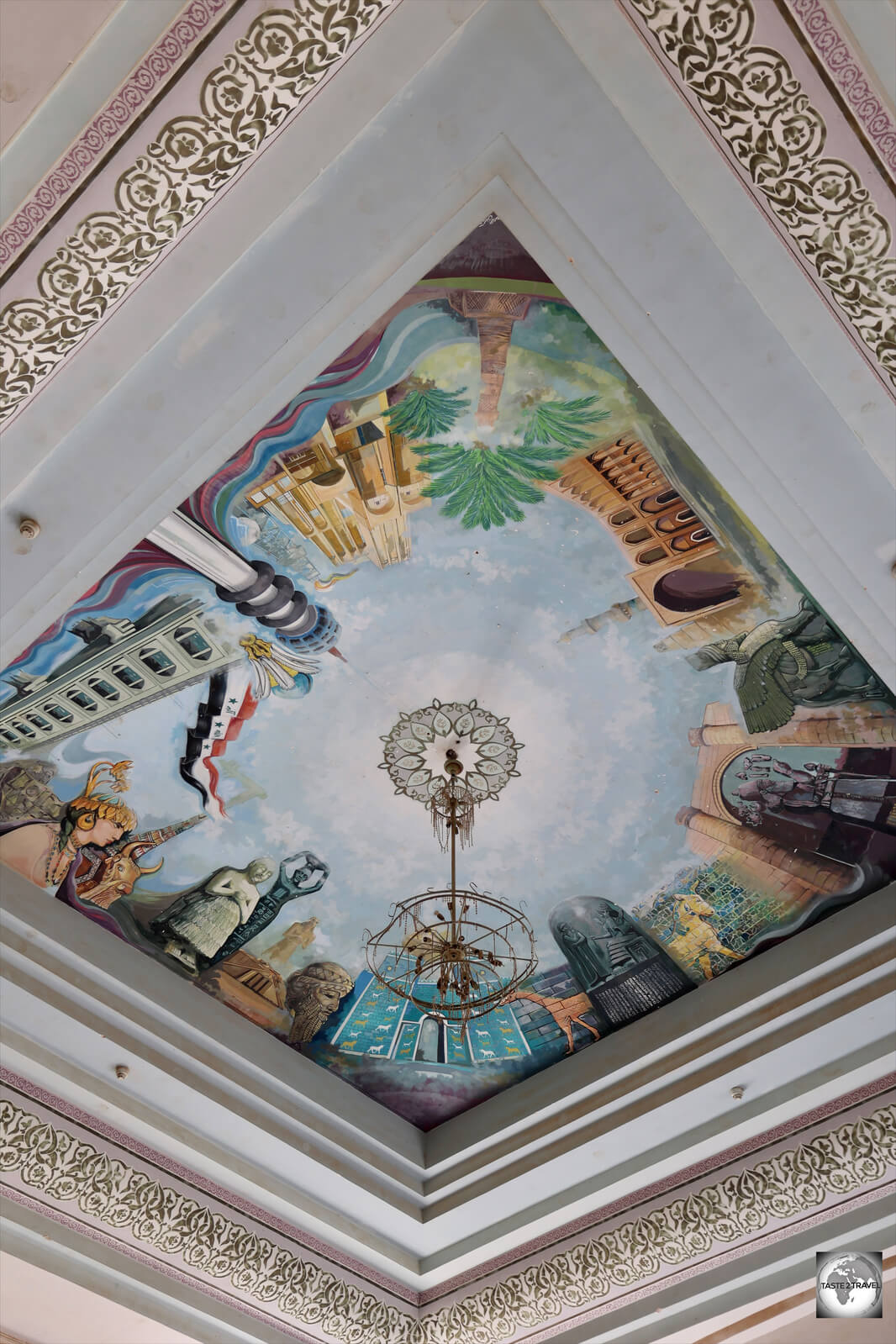
Detail of ceiling fresco in the throne room of Saddam’s Babylon palace.
Iraq is a country which has a long way to go before it can be considered a ‘normal’ travel destination. It’s currently dusting itself off after many decades of war.
There is still a heavy military presence in the streets, with heavily armed soldiers everywhere, sitting in their armoured Humvees which are equipped with turrets and mounted machine guns. I was told by Iraqi friends that the security situation is very volatile and that a visible military presence is still required.
During my visit, the Shia cleric, turned politician, the powerful and influential Moqtada al-Sadr announced in a Tweet that he was quitting politics.

Truly opulent! The Al-Askari Shrine in Samarra.
This news outraged his many passionate supporters who took to the streets of Baghdad with machine guns and other heavy weapons. They stormed the secure ‘Green Zone’, overran the Presidential Palace and at the end of the day, there were many fatalities.
The country was placed under a national curfew, I was told not to leave the hotel! The violence only ended the following day after Moqtada al-Sadr called for calm.

A view of Baghdad souk with Shia flags flying overhead.
I enjoyed my time in Iraq and look forward to returning again one day to explore further.]
I would recommend Iraq as a travel destination for those who are intrepid. Everywhere I travelled, I had amazing, world-class, sights to myself. Such a privilege!
Location
Baghdad, Iraq
Iraq is bordered to the north by Turkey, to the east by Iran, to the west by Syria and Jordan, and to the south by Saudi Arabia and Kuwait. It is one of the easternmost countries in the Middle East.
The country is almost landlocked, with only 58 km (36 mi) of coastline along the northern end of the Persian Gulf.
History
Ancient History
During ancient times, lands that now constitute Iraq were known as Mesopotamia (“Land Between the Rivers”), a region whose extensive alluvial plains gave rise to some of the world’s earliest civilisations, including those of Sumer, Akkad, Babylon, and Assyria.
Home to many great past civilisations, Iraq has been previously incorporated into the Persian, Greek, Roman and Ottoman empires.
Monarchy
During the colonial period, Iraq was governed by the British, until the country gained formal independence in 1932.
In 1932, the British installed an Iraqi Monarch, who never gained widespread acceptance by the local population.
Short-lived, there were just three Iraqi monarchs:
- King Faisal I – ruled from 1932 to 1933
- King Ghazi – ruled from 1933 to 1939
- King Faisal II – ruled from 1939 to 1958
Political instability on an even greater scale followed the overthrow of the monarch, King Faisal II, in 1958, but the installation of an Arab nationalist and socialist regime, the Baath Party, in a bloodless coup 10 years later brought new stability.
With proven oil reserves second in the world only to those of Saudi Arabia, the regime was able to finance ambitious projects and development plans throughout the 1970s and to build one of the largest and best-equipped armed forces in the Arab world.
Saddam Hussein
The party’s leadership, however, was quickly assumed by Saddam Hussein, a flamboyant and ruthless autocrat who led the country into disastrous military adventures, the Iran-Iraq War (1980–88) and the Persian Gulf War (1990–91).
These conflicts left the country isolated from the international community and financially and socially drained, but, through unprecedented coercion directed at major sections of the population, particularly the Kurdish minority and the Shia majority, Saddam was able to maintain a firm hold on power into the 21st century.
Saddam, and his regime, were toppled in 2003 during the Iraq War.
Iraq Today
Today, Iraq is split into two entities, Federal Iraq and Iraqi Kurdistan, with Kurdistan being an autonomous region which is home to the Kurdish minority.
Iraqi Kurdistan, which is covered in my Iraqi Kurdistan Travel Guide, is ruled by its own government, has its own parliament, president and immigration procedures.
Iraqi Kurdistan is a much more secure and stable region of Iraq and is a great option for those who wish to visit a part of Iraq which has been open to tourists for many years.
People

A Shia pilgrim at the Imam Ali Shrine in Najaf.
Modern Iraq, created by combining three separate Ottoman provinces in the aftermath of World War I, is one of the most religiously and ethnically diverse societies in the Middle East. Although Iraq’s communities generally coexisted peacefully, fault lines between communities deepened in the 20th century as a succession of authoritarian regimes ruled by exploiting tribal, sectarian, and ethnic divisions.
The ancient Semitic peoples of Iraq, the Babylonians and Assyrians, and the non-Semitic Sumerians were long ago assimilated by successive waves of immigrants. The Arab conquests of the 7th century brought about the Arabization of central and southern Iraq. A mixed population of Kurds and Arabs inhabit a transition zone between those areas and Iraqi Kurdistan in the northeast. Roughly two-thirds of Iraq’s people are Arabs, about one-fourth are Kurds, and the remainder consists of small minority groups.

Copper merchant in Baghdad souk.
Sunnis / Shias
Many of the issues with have plagued Iraq throughout its history stem from the fact that the population is divided between Sunni and Shi’ite Muslims.
From the inception of the Iraqi state in 1920, until the fall of the government of Saddam Hussein in 2003, the ruling elites consisted mainly, although not exclusively, of minority Sunni Arabs.
Under Saddam Hussein’s regime in Iraq, which was dominated by Sunnis, the country clashed with Iran (which is led by a Shi’ite government).
Although Shias constituted the majority of the population, Iraq’s Sunni rulers gave preferential treatment to influential Sunni tribal networks, and Sunnis dominated the military officer corps and civil service.
The Sunni-Shia divide is nearly 1,400 years old, dating back to a dispute over the succession of leadership in the Muslim community following the death of the Prophet Muhammad in 632 CE.
Despite periods of open conflict between Sunnis and Shias in Iraq, the two groups are not all that different in terms of religious beliefs and commitment.
In Iraq, for example, both groups express virtually universal belief in God and the Prophet Muhammad, and similar percentages (82% of Shias and 83% of Sunnis) say religion is very important in their lives. More than nine-in-ten Iraqi Shias (93%) and Sunnis (96%) say they fast during the holy month of Ramadan.
The Shias tend to be far more flamboyant about their brand of Islam, with flags seen flying all over Shia neighbourhoods and towns, many bearing images of Ali and other Imams.
At the al-Abbas shrine in Karbala, Shia pilgrims can be seen parading around, and through, the shrine in ritual self-flagellation. The Shias very much wear their religion on their sleeves.
Shias remained politically and economically marginalized until the fall of Saddam Hussein’s regime. Since the transition to elective government, Shia factions have wielded significant political power, especially Moqtada al-Sadr, a nationalist cleric who leads one powerful faction.
Most recently, during my visit to Iraq, tensions flared when al-Sadr announced that he was quitting politics. The ensuing unrest resulted in many deaths and a national curfew being enforced. The unrest ended once al-Sadr called for calm.
Flag
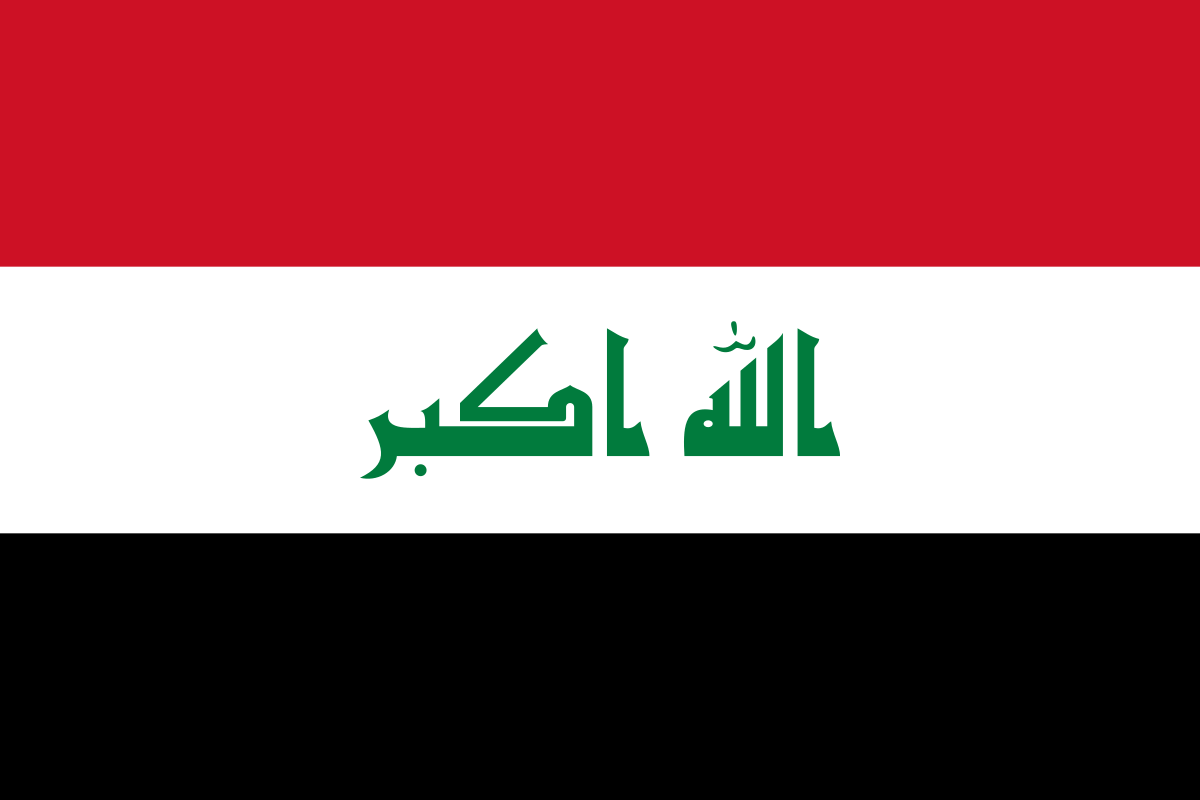
The flag of Iraq.
The flag of Iraq is based on the Arab Liberation flag, which uses the pan-Arab colours of red, white, and black.
Red symbolises the courage and struggles of the nation, while black represents both the oppression and triumph of the Islamic religion. White symbolises the future of Iraq and the generosity of its people.
Centred in the white band is the Takbir, a phrase that means “God is great”, written in Kufic script. The Takbir is written in green, the colour of Islam.
Currency

My wad of 100, uncirculated, IQD250 banknotes.
The official currency of Iraq is the Iraqi dinar (IQD).
Current bank notes, which are issued by the Central Bank of Iraq, include IQD 250; 500; 1,000; 5,000; 10,000; 25,000 – and the rarely seen 50,000.

Iraqi dinar bank notes.
If you’re interested in getting your hands on a brand-new IQD 50,000 note, I often received these from Bank of Baghdad ATMs.

Iraqi IQD 50,000 bank notes.
The Iraqi dinar isn’t a free-floating currency, with the exchange rate set by the Iraqi government at US$1 = IQD 1,460. This exchange rate is factored into government budgets until at least 2026.

Iraqi IQD 25,000 bank notes.
Exchange Rates
The current exchange rate of the Iraqi dinar against US $100 and €100 are:
Saddam Hussein Dinars

Saddam Hussein dinars make for an interesting souvenir.
Prior to the 1st Gulf War in 1990, high quality Iraqi dinar bank notes were printed in the United Kingdom by Thomas De La Rue.
Following the introduction of United Nations sanctions after the war, Iraq was no longer able to place currency orders with Thomas De La Rue.
A new series of bank notes were printed locally, which featured a portrait of Saddam Hussein. Known as “Saddam dinars”, the notes were of inferior quality, compared to the former UK-made bank notes, which then become known as “Swiss dinars”.
Due to prolonged international sanctions on Iraq, along with excessive government currency printing, the Saddam dinar quickly became worthless.
After Saddam Hussein was deposed in the 2003 invasion of Iraq, the Iraqi government printed more Saddam dinar notes as a stopgap measure to maintain the money supply until a new currency could be introduced.
The market had become flooded with worthless Saddam dinars.

Wads of Saddam Hussein diners at a money exchange in Erbil souk.
Between 2003 and 2004, the Coalition Provisional Authority issued new Iraqi dinar notes, which were printed, once again, by Thomas De La Rue in the UK.
Trillions of new dinars were shipped to Iraq and exchanged for the old Saddam dinar notes at par value.
Today, wads of souvenir Saddam Hussein dinar notes can be found at money changers throughout Iraq and Iraqi Kurdistan. Each note can be purchased for IQD 1,000 (USD$0.68), making them more valuable as a souvenir than what they were when in circulation.
Banking Services
Credit Cards
Iraq is a cash society. Credit cards are accepted almost nowhere, although I was able to settle my bill at my hotel in Baghdad using my credit card.
Generally, all payments in Iraq are to be made using cash!
ATMs
You will never find an ATM on the street in Iraq.
ATMs are only found inside the larger shopping malls and at international airport terminals.
Bank branches are also non-existent, with informal money changers providing money exchange services on the street.
Not all banks are on the international network. The two banks which I found to be most reliable, and whose ATM’s accept international credit cards (i.e. Mastercard and Visa), are the Bank of Baghdad and Cihan Bank.
Iraqi Tourist Guide

My guide Fahad, of Iraq Adventures, on top of the Malwiya minaret, with the Great Mosque of Samarra in the background.
Due to the unique security situation in Iraq – that is, a large degree of insecurity – it can be best to employ the services of a local guide, even, if like myself, that isn’t the way you would normally roll.
Certain towns, such as Samarra, are controlled by militia groups, who are more like a militarised neighbourhood watch than anything sinister and bad.
Following bombings by Al-Qaeda which destroyed the holy shrine in Samarra, it was clear to locals that security could not be assured by the Iraqi government. The militia protect Samarra and ensure anyone entering is registered first. Due to the presence of the militia, Samarra is much cleaner, safer and much better organised than other towns and cities in Iraq.
When entering Samarra, tourists are required to surrender their passports at a checkpoint, which will be handed back at the time you exit town. The guards speak almost no English and much prefer that foreigners are escorted by a local.
Having a local guide who knows the procedure and can do the talking is very helpful.

Exploring the remote desert fortress of Al-Ukhaidir with Fahad of Iraq Adventures.
Likewise, gaining access to the remote desert fortress of Al-Ukhaidir isn’t always assured since the ticket office isn’t always open. Before we drove 50-km into the desert, Fahad called ahead to ensure the ticket office would be open when we arrived.
Fahad is available for daytrips or multi-day trips.
Fahad, who is available for daytrips, or multi-day trips, can be contacted at:
Instagram: instagram.com/iraq.adventure
WhatsApp: +964 771 561 7966
Email: iraqadventure1@gmail.com
Sightseeing

Some of the most dazzling sights in Iraq are the Shia holy shrines of Karbala, Najaf and Samarra.
Being the cradle of civilisation, Iraq is full of hugely important historical sights.
As the home of the most important shrines for Shia Islam, the cities of Karbala, Najaf and Samarra are important pilgrimage destinations, attracting millions of pilgrims each year.
Housed inside intricately decorated mosques, the shrines are truly dazzling sights with an incredible atmosphere.

Beautifully intricate tilework, such as on this shop in Baghdad, can be found throughout Iraq.
Important Note: When visiting any of the holy shrines in Karbala, Najaf and Samarra, large bags and large (DSLR) cameras are not allowed inside. There are secure baggage rooms where you can store such items free of charge. These rooms are very safe and secure. I used them often.
Only mobile phones are permitted inside the shrines and can be used to take photos. In the day of the selfie, many Shia pilgrims want to pause to capture the moment with a selfie. Everyone is busy taking photos and photography is, generally, not a problem.
However, in the rooms which house the actually shrines, photography isn’t allowed. Within these rooms, a team of friendly doormen, who are armed with long-handled feather dusters, ensure people keep moving and don’t stop the traffic flow by stopping to take photos.
If you do try to take a photo, you can expect a polite tap on your arm, or head, from a feather duster. Of course, the pilgrims all want photos of themselves in front of the shrines! I did manage to take a few quick photos at each location whenever the doormen were busy berating someone else! :-))
Baghdad

The iconic Martyr’s Monument, which was covered in a layer of desert dust at the time of my visit, is a highlight of Baghdad.
Martyr’s Monument

The iconic Martyr’s Monument in Baghdad was originally dedicated to the Iraqi soldiers who died in the Iran–Iraq War.
The iconic landmark of Bagdad, Martyr’s Monument is a monument designed by Iraqi sculptor Ismail Fatah Al Turk.

A view of the domes – which represent life and death at Martyr’s Monument.
Commissioned by Saddam Hussein, and completed in 1983, the monument was originally dedicated to the Iraqi soldiers who died in the Iran–Iraq War (1980 – 1988), but has since grown to become a memorial of all Iraqi martyrs.
The monument design features a 40-m tall split turquoise dome. The two halves of the split dome are offset, with an eternal flame in the middle.

Detail of Martyr’s Monument, Baghdad.
Commenting on the design of the memorial, the architect, Al Turk, commented:
“The idea of life versus death began to form. The two (dome) pieces moving together towards martyrdom and fertility and the life stream. I moved the pieces until I got the interplay I wanted.”.

The underground museum complex at Martyr’s Monument.
A spiral staircase descends to a subterranean museum complex. At the time of my visit, I was the only visitor at the complex. Museum staff opened the museum so I could visit it.
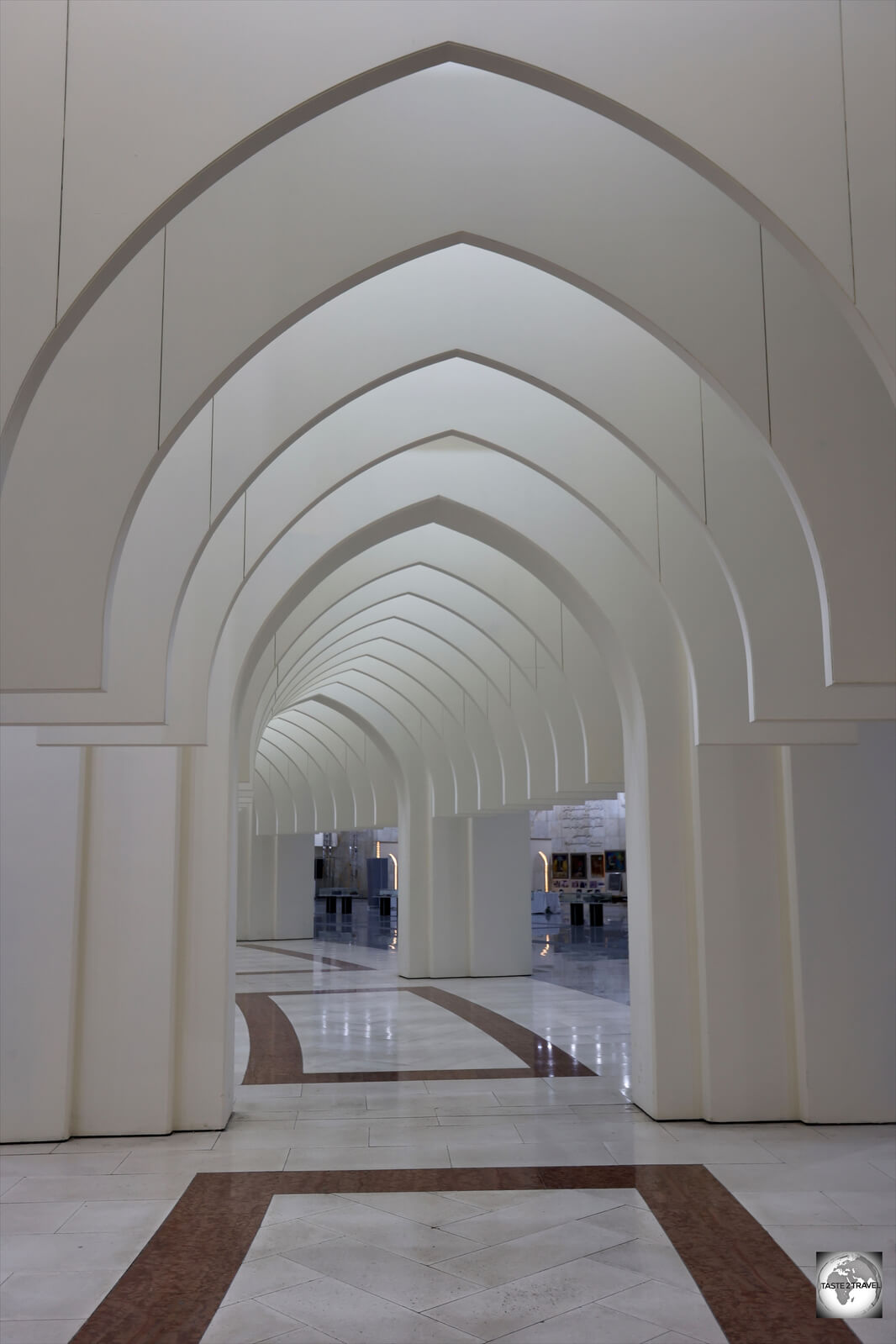
The interior of the very quiet museum, beneath Martyr’s Monument.
Access:
The monument is open from 8 am to 3 pm daily. It is a shame you are not able to access the monument during sun set and the magical blue hour. Tickets cost IQD 5,000 for tourists.
While there are two entrances to the memorial, the only entrance open to visitors is the fortified entrance on Omar Bin Al Khatab Street.
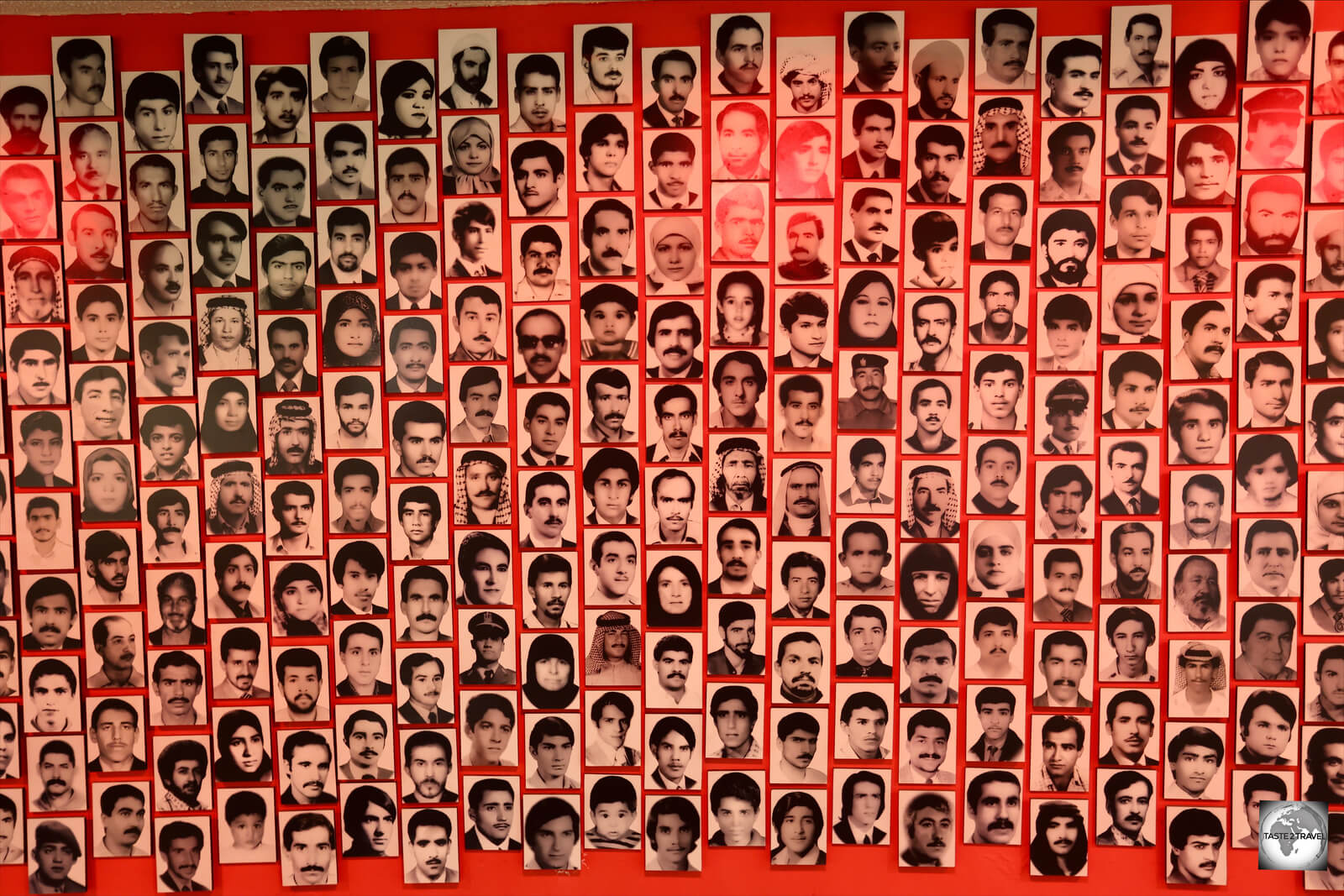
Photos of Iraqi martyrs, at the Martyr’s Monument Museum in Baghdad.
Iraq Museum

A highlight of the Iraq Museum, a pair of marble, winged-bull Lamassus which once guarded the entrance to the Assyrian city of Khorsabad.
As a cradle of civilisation, Iraq is very rich in history. It was in Iraq that humanity finally stopped roaming the earth and instead settled in urban areas for the first time.
The rich history of the country can be seen on display at the highly important Iraq Museum in Baghdad. The museum houses precious artefacts from the Mesopotamian, Abbasid and Persian civilisations.

Detail of marble panels from the Assyrian city of Khorsabad.
A highlight of the museum is a pair of marble, winged-bull Lamassus which once guarded the entrance to the Assyrian city of Khorsabad. The winged bull is a compound mythical creature which consists of a human head, the body of a bull and the wings of an eagle.

Walking lion from the Processional Way, part of the ancient city of Babylon.
During the colonial era, many artefacts from Iraq were illegally removed during archaeological excavations. These artefacts ended up in museums in Europe and America.
One of the more famous thefts occurred while German archaeologists were working at Babylon from 1904 to 1914. During this time, the entire Ishtar gate and sections of the tiled-Processional Way were removed from Babylon and sent to German. The gate was reconstructed inside the Pergamon Museum in Berlin where it can be seen today.
The Iraq Museum has called for all artefacts to be returned to Iraq. In the meantime, the museum includes one lion from the Processional Way at Babylon.
The precious relics housed in the Iraq museum have not been spared from the ravages of recent wars. On April 8, 2003 (during the 2nd Gulf War) museum staff were ordered to leave the museum. Days later, the museum was looted with 15,000 objects being stolen. The steel exterior doors were not forced – it was an inside job. The looting ended once U.S. forces arrived on April 16.
After being closed for many years while being refurbished, and rarely open for public viewing, the museum was officially reopened in February 2015. It is a highlight of Iraq and should not be missed.
Access:
Tickets (predictably) cost IQD5,000 for foreigners!
Opening times are not as indicated on Google – best to call ahead.
Copper Market (Al-Safafeer Souk)

The copper market at Al-Safafeer souk is a highlight of the bustling Baghdad bizarre.
For more than 300 years, copper merchants at the Al-Safafeer souk in the heart of Baghdad have been selling hand-crafted copperware.

Copper artisan at the al-Safafeer copper market in Baghdad.
The name of the souk is derived from ‘safra’ – the Arabic word for copper.

A friendly copper merchant at the Al-Safafeer copper market in Baghdad.
The copper market is lined with shops which are stuffed to the rafters with every sort of copperware imaginable. The friendly merchants will do their best to ensure you don’t leave empty-handed!

An Aladdin’s Cave of copperware at the Baghdad copper market.
While it can be difficult to locate in the rabbit-warren of chaotic alleyways which comprises the sprawling Baghdad souk, the copper market occupies a 500-metre-long souk which is a short walk from the Madrassa al-Mustansiriya and Al-Mutanabi street – the famous street of the book sellers.

An artisan, engraving a copper platter at the Al-Safafeer copper market in Baghdad.
Mustansiriya Madrasah

A view of the main entrance to the Mustansiriya Madrasah.
A short stroll along the banks of the Tigris River from the copper market, a hidden entrance leads you into another world – a tranquil oasis in the middle of the bustling souk.
The beautiful Mustansiriya Madrasah was established in 1227 CE, on the banks of the Tigris River, as a learning centre.
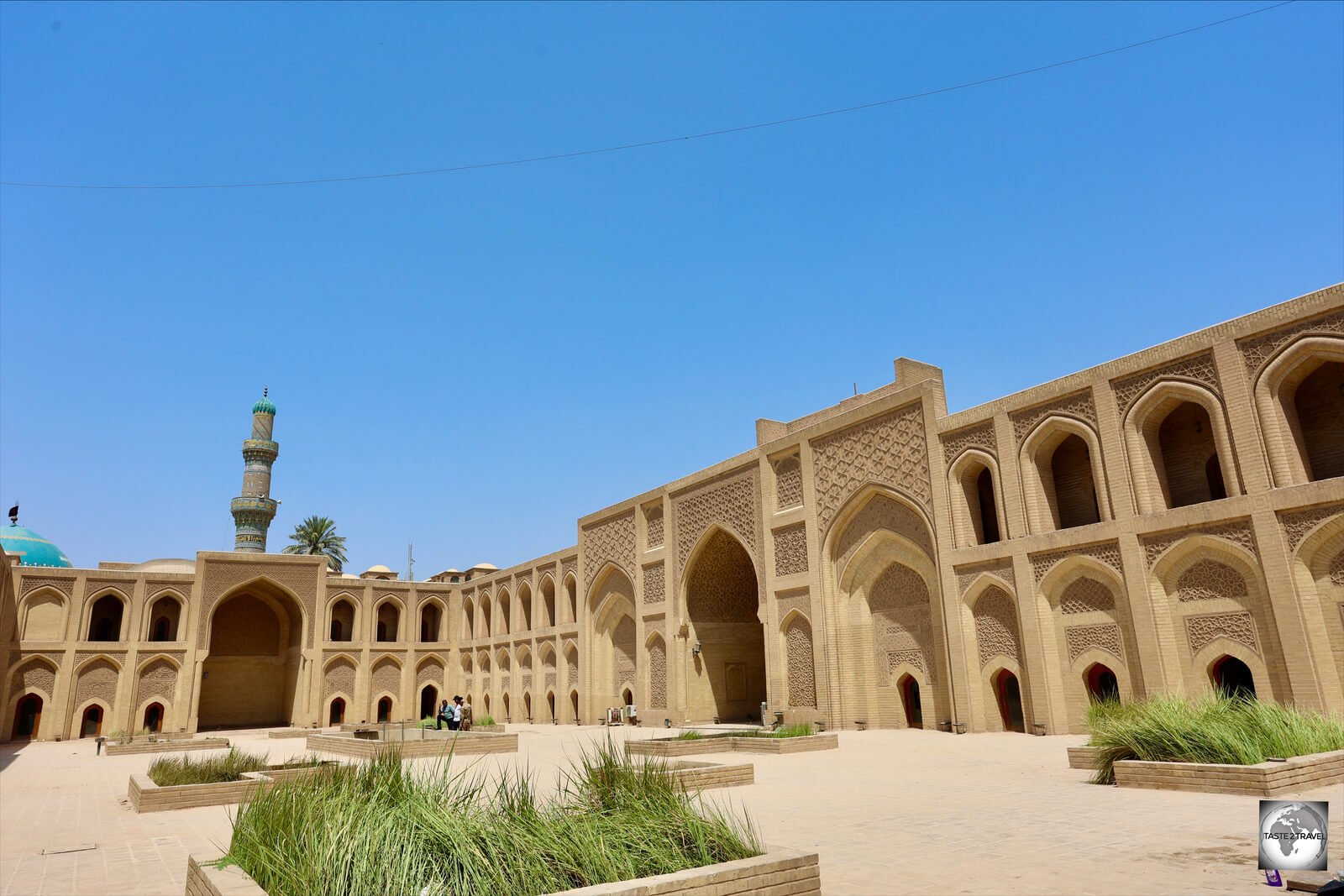
The courtyard of the 13th-century Mustansiriya Madrasah in central Baghdad.
The Madrasa taught many different subjects, including medicine, math, literature, grammar, philosophy, and Islamic religious studies. However, the major focus of education was Islamic law.

A view of the Mustansiriya Madrasah, a former Islamic centre of learning.
The Madrasah has seen many ups and downs during its history, including being sacked by Genghis Khan during his invasion of Baghdad in 1258.

The Mustansiriya Madrasah, which is slowly being restored, features the most beautiful of Islamic architecture.
Today, this historic complex is slowly being restored.
At the time of my visit, I had the entire complex to myself – an oasis of calm! A good time to visit is during the call-to-prayer, which rings out over the entire complex from the adjacent mosque.
Access: Open during daylight hours, the madrasah is located on the banks of the Tigris River, alongside the Al-Shuhada Bridge.
Like everywhere else in Iraq, entrance tickets cost IQD5,000.
Babylon

The very garish Ishtar Gate, the main entrance to ancient Babylon, is a modern reproduction, built under the orders of Saddam Hussein.
Ancient Babylon

The modern walls of ancient Babylon were constructed in the 1980’s under orders from Saddam Hussein.
Babylon, or Babel, is one of the most famous cities of antiquity and was considered one of the world’s greatest cities from the 18th to the 6th Century BCE.
Babylon served as the capital of southern Mesopotamia and Assyria (Northern Iraq) from the 2nd millennium to the 1st millennium BCE and later as the capital of the Neo-Babylonian empire in the 7th and 6th Centuries BCE. It was occupied by Alexander the Great in the 4th Century BCE
From the Tower of Babel to the Hanging Gardens, the grandeur and spender of Babylon has provided humanity with plenty of stories and myths.

The walls of Babylon were reconstructed by Saddam Hussein in the 1980’s.
The city reached the height of its splendour during the reign of King Nebuchadnezzar II, the second king of the Neo-Babylonian Empire. He reigned from 605 BC to his death in 562 BC. Historically known as Nebuchadnezzar the Great, he is regarded as the empire’s greatest king.
Nebuchadrezzar’s Babylon was the largest city in the world, covering about 10 square km (4 square miles), the first city in the world to have a population in excess of 200,000 inhabitants.
The Euphrates, which has since shifted its course, once flowed through the centre of the city. In its heyday, Babylon was considered the capital of the known world.

The labyrinth, which Nebuchadnezzar had built around his palace, can be clearly seen here.
One interesting aspect of Babylon is the walled labyrinth which Nebuchadnezzar had built around his palace. A very effective security system, which made it impossible for would-be attackers to reach the palace.

A view from inside the labyrinth which surrounds the palace of Nebuchadnezzar II at Babylon.
As you walk through the labyrinth, corridors narrow, eventually reaching dead-ends. You then have to find your way back to your starting point which is very difficult. Very clever!
During his rule, Saddam Hussein became obsessed with Nebuchadnezzar, who is notorious for waging bloody wars to seize large swaths of current-day Iran and Israel.
Saddam saw himself as a modern reincarnation of Nebuchadnezzar, and to prove it, he spent millions building a massive reconstruction of Babylon – an ill-conceived project which has forever damaged the sight.
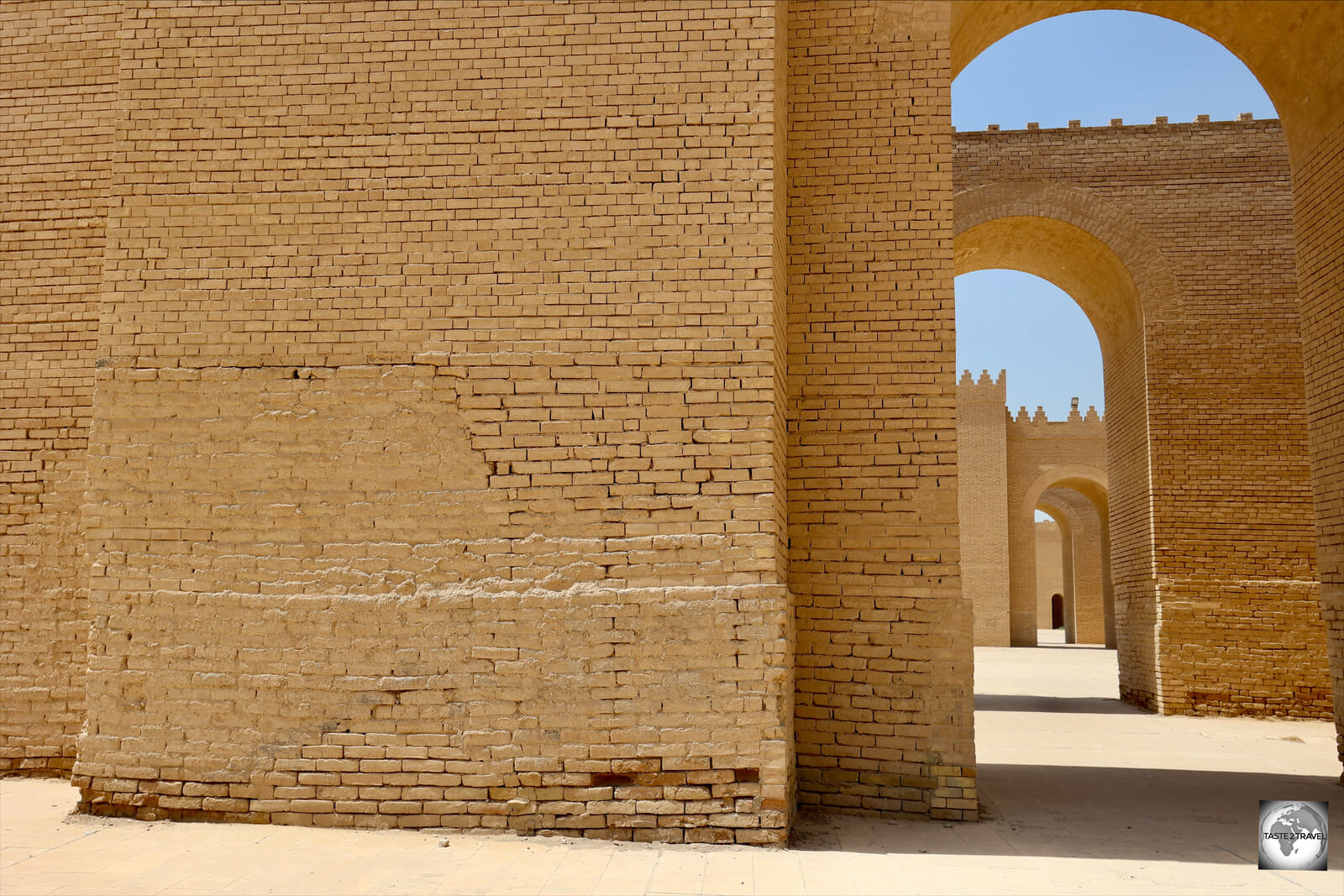
The walls of Babylon were reconstructed by Saddam Hussein in the 1980’s.
During the 1980’s, while the Iran-Iraq War was being fought, Saddam ordered new, higher walls to be built over the top of the original walls.
In the above image, you can see the original walls which are about 1-2 metres in height, with the newer, neater, walls from the 1980’s built over the top.

Modern bricks at Babylon which have been stamped with Saddam Hussein’s name.
When archaeologists told Saddam that ancient kings had stamped their names on Babylon’s bricks, Saddam insisted that his own name be stamped on the bricks used in the reconstruction.
Bricks laid during the reconstruction bear Arabic script which translates as:
‘In the reign of the victorious Saddam Hussein, the president of the Republic, may God keep him, the guardian of the great Iraq and the renovator of its renaissance and the builder of its great civilization, the rebuilding of the great city of Babylon was done in 1987.”
As part of the strengthening of the city’s defensive walls, each ruler of Babylon increased the height of the walls. Saddam decided to out-do them all by ordering the new walls to be built to an improbable height of 11.5m (38ft).
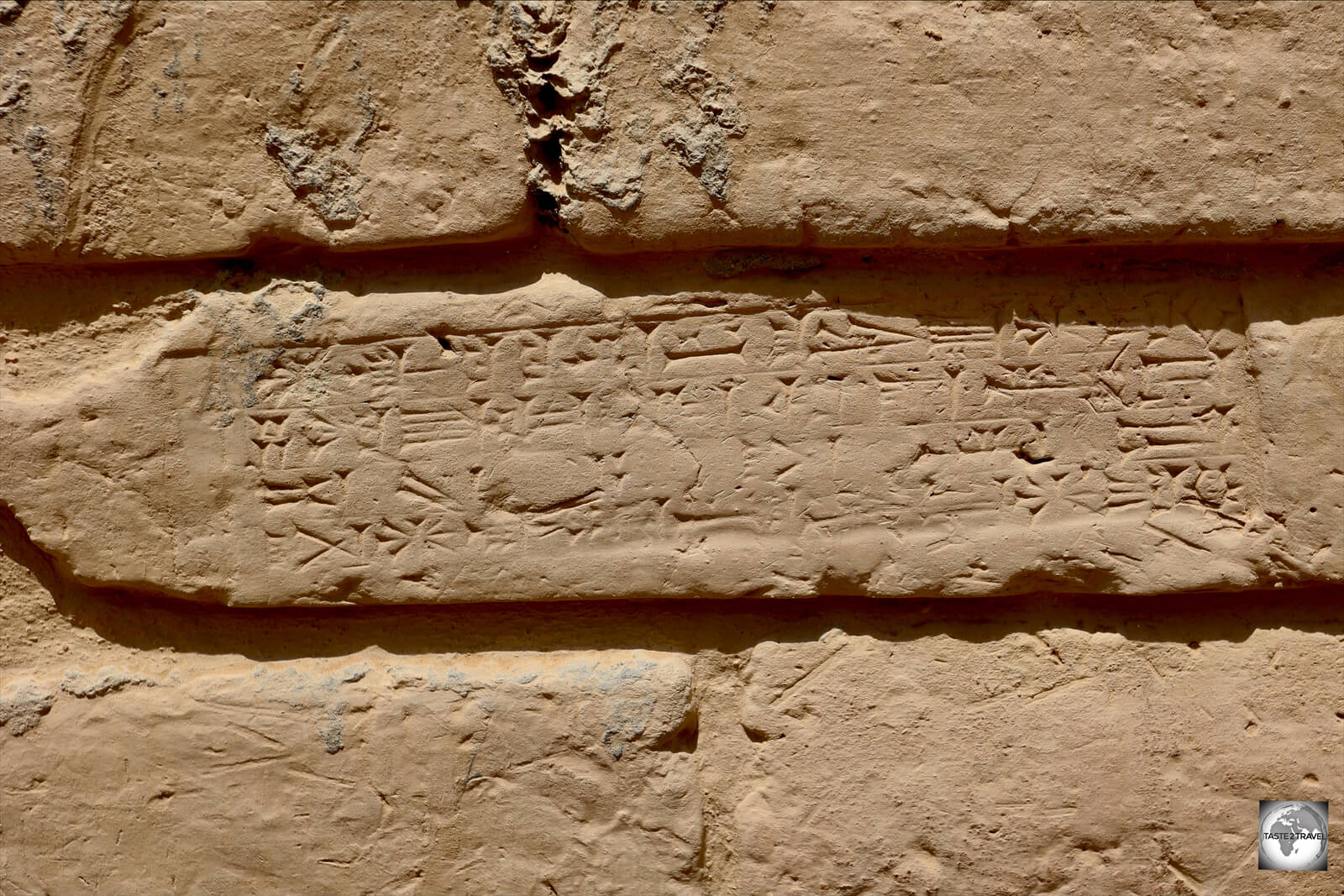
An ancient brick at Babylon, which has been stamped with the name of a former ruler.
Today, these towering walls overlook empty, dusty courtyards. During my visit the temperature was around 50 degrees Celsius, with the walls at least providing some shady relief from the blistering heat.
Saddam clearly saw Babylon as a personal Disneyland, with the tackiness reaching its zenith with the reconstructed Ishtar Gate, the main access point which is the first stop for all visitors.

A map at Babylon, showing the ancient cities of Iraq.
Today, Babylon is open for tourists with one of the government guides being a lifetime resident of the area.
He told me his entire village was evicted from their hilltop location in the 1990’s, when Saddam decided the hill would be the perfect location for his Babylon Palace (see next section).
Access:
Located on the Euphrates River, 88 km (55 miles) south of Baghdad via a fast highway, Babylon lies on the outskirts of the modern city of Al-Hillah.
If you’re travelling from Baghdad via shared taxi, you should take a taxi to ‘Hillah‘ (IQD???). From Hillah, Babylon is a 10-minute drive.
There are no services (restaurants, shops, cafes etc) at Babylon. In the blistering heat, you should ensure you are carrying lots of water.
Entrance tickets cost IQD25,000!
Saddam’s Babylon Palace

Built in the style of a Ziggurat, Saddam Hussein’s palace overlooks the ruins of Babylon.
During his reign, it’s estimated that Saddam Hussein had 100 palaces constructed throughout Iraq. One of the most important was his palace at Babylon

A view of ancient Babylon from Saddam Hussein’s palace complex.
The palace, which is modelled on an ancient Ziggurat (a Mesopotamian, rectangular stepped tower) was built on a hill which lies adjacent to the ancient city.

A view of the Euphrates, and an extensive date palmerie, from the balcony of Saddam Hussein’s palace in Babylon.
As he considered himself to be ‘above’ all other rulers of Iraq – both ancient and modern – he saw it as fitting that his palace should be built on higher ground, so he could look down upon Babylon!

The front of Saddam Hussein’s Babylon palace – one of more than 100 palaces he built across Iraq.
The palace, which was built during the economic embargo in the wake of the 1st Gulf War (1991), required the eviction of an entire village.

A palace door lintel features a bust of Saddam Hussein in an ancient, Babylonian, setting.
One of these villagers is currently working as a guide at Babylon and is full of interesting stories from the time of Saddam.

A view of one of the many rooms of the palace, all of which feature marble floors.
The many rooms of the palace, which today lay in ruin, feature marble floors, timber panelling and broken chandeliers. Anything that could have been looted was removed years ago.

A former dining hall, with marble-mosaic floors, and walls covered in graffiti, inside Saddam’s Babylon Palace.
During the 2nd Gulf War, from 2003 to 2011, U.S. and Polish forces used the palace as their headquarters and did not allow citizens to visit it.

The former bedroom of Saddam Hussein, who reportedly stayed in the palace on just one occasion.
After 2011, Iraqis were finally given access to the palace, which today is open to the elements and in a state of slow decay.

A former, marble-clad, bathroom is now covered in graffiti.
The graffiti-covered walls bear testament to the many visitors who have passed through the palace since 2003, with English, Polish and Arabic graffiti to be found throughout.
One piece of artwork which remains untouched is a ceiling fresco which lies in the centre of the throne room. This fresco features scenes from Babylon and the other ancient cities of Mesopotamia.

A view of the throne room at Saddam Hussein’s Babylon palace.
It is rumoured that Saddam Hussein came to the palace, which reportedly took four years to build, only once. A special access road was built for him, which was also used just once!

A view of the former palace swimming pool from the master bedroom.
The exterior walls of the palace feature are engraved with the initials of Saddam Hussein in Arab script.
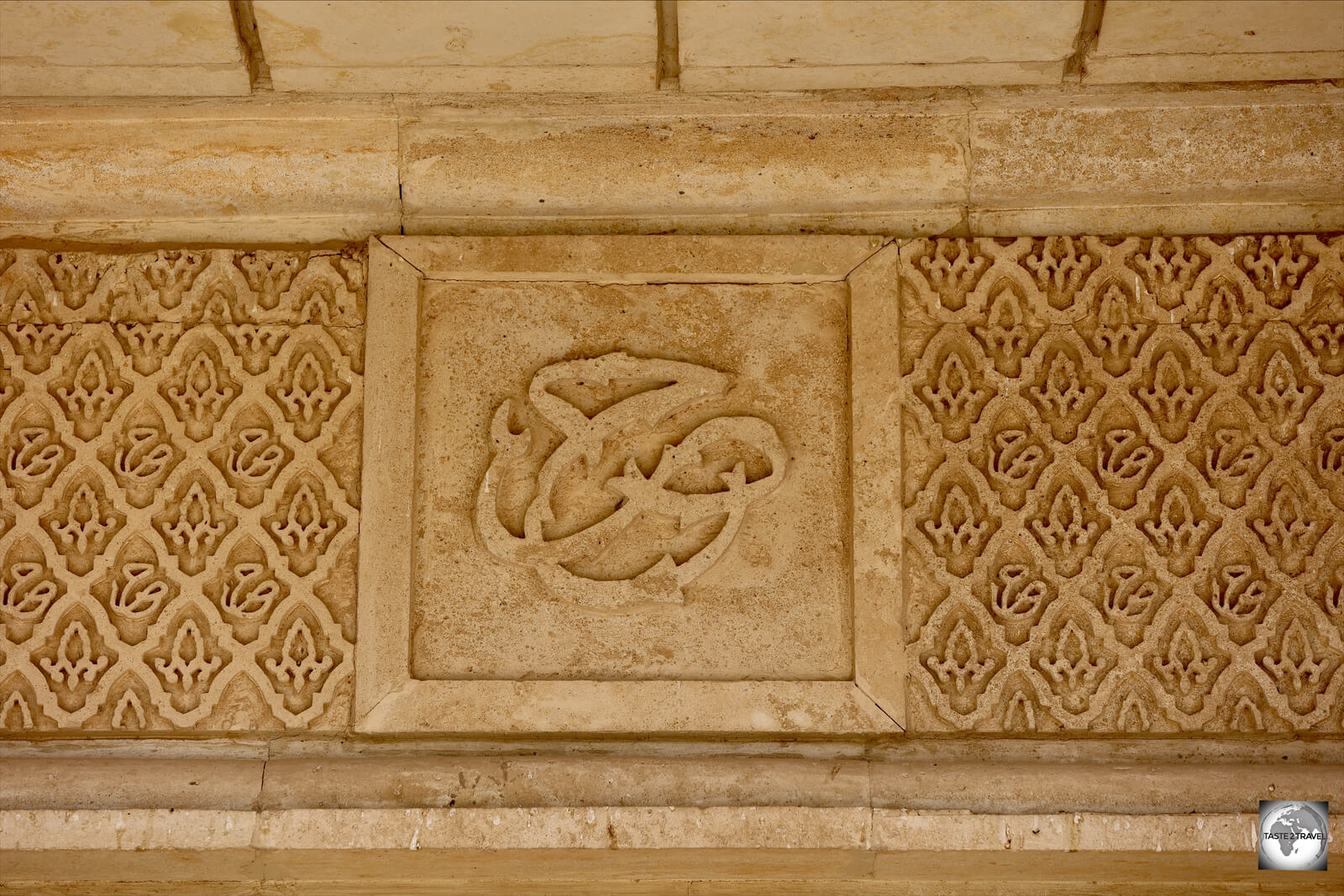
The arabesque initials of Saddam Hussein line the exterior walls of the palace.
Samarra
Located 95 km (60 miles) north of Baghdad, Samarra is an ancient city which is home to a number of important sights, including the Great Mosque of Samarra and the Al-Askari Shrine, one of the holiest sites for Shiite Muslims.
Samarra served as the second capital of the Abbasid Caliphate after Baghdad, ruling over the provinces of the Abbasid Empire which extended from Tunisia to Central Asia.
Despite its close proximity to Baghdad, the journey to/ from Samarra can take more than 2 hours due to the woeful condition of National Highway #1. A poorly maintained highway which is highly congested, improvement works are currently being performed.
I travelled to Samarra, with my guide Fahad, in a shared taxi.
During the journey, a small KIA truck lost two of its rear tyres while travelling, at speed, in the opposite direction.
These rogue, out-of-control, tyres came flying across the highway and slammed into the front of our taxi, completely destroying all of the front panels.
Luckily, there was no damage to the engine and no one was injured. I was sitting in the front passenger seat and watched it all, in what seemed like slow motion.

Our damaged taxi, after it was slammed by two runaway tyres.
In a country where no one has insurance, the process of compensation is that the driver at fault must make a cash payment to the victim before leaving the scene. The driver of the truck agreed to pay the equivalent of US$150, which was the amount the taxi driver claimed would be required to replace the damaged panels.
The rouge tyres of course didn’t just hit our taxi. Also standing in line, waiting to make their claims, were two other drivers whose cars had been damaged.
Hopefully the truck driver had deep pockets!
Great Mosque of Samarra

A highlight of Samarra is the iconic Malwiya (Arabic for “twisted”) Minaret.
Located close to the banks of the Tigris River, the Great Mosque of Samarra was built in the 9th century, on the orders of the Abbasid caliph Al-Mutawakkil, who moved to Samarra to escape conflict with the local population in Baghdad.

A view of the former Great Mosque of Samarra, once the largest mosque in the world, from the top of the adjacent minaret.
Al-Mutawakkil remained in Samarra for the next 56 years, where he built many palaces and the largest mosque in all of Islam. The Great Mosque remained the largest mosque in the world for the next 400 years before it was destroyed by the armies of the Mongol ruler Hulagu Khan in 1278 CE.

The Malwiya minaret is featured on the back of the IQD250 banknote.
The outer walls and the imposing 52-metre-high minaret is all that remains of this once ‘Great Mosque’.
The mosque has a rectangular layout encompassed by an outer brick wall, 10 m high and 2.65 m thick, and supported by a total of 44 semi-circular towers.

A group of Iraqi tourists, descending the Malwiya minaret at Samarra.
Adjacent to the mosque stands the Malwiya minaret with its vast spiraling cone 52 m high and 33 m wide at the base.
At the top of the tower rests a round vestibule, which is adorned with eight pointed-arched niches.
It is possible to walk all the way to the top along the spiraling path – a challenge for anyone who suffers from vertigo. The desert winds towards the top of the tower can become fierce and, at times, seem determined to blow you off the tower.

An intrepid Thai traveller, and his Iraqi guide, waving from the Malwiya minaret.
It is rumoured that the caliph, Al-Mutawakkil, liked to ride his donkey to the top of the tower to enjoy the view.
The minaret was partially destroyed in April 2005, when insurgents bombed the tower because US troops had been using it as a lookout position.
The Samarra Archaeological City was listed as a UNESCO World Heritage Site in 2007.
Al-Askari Shrine
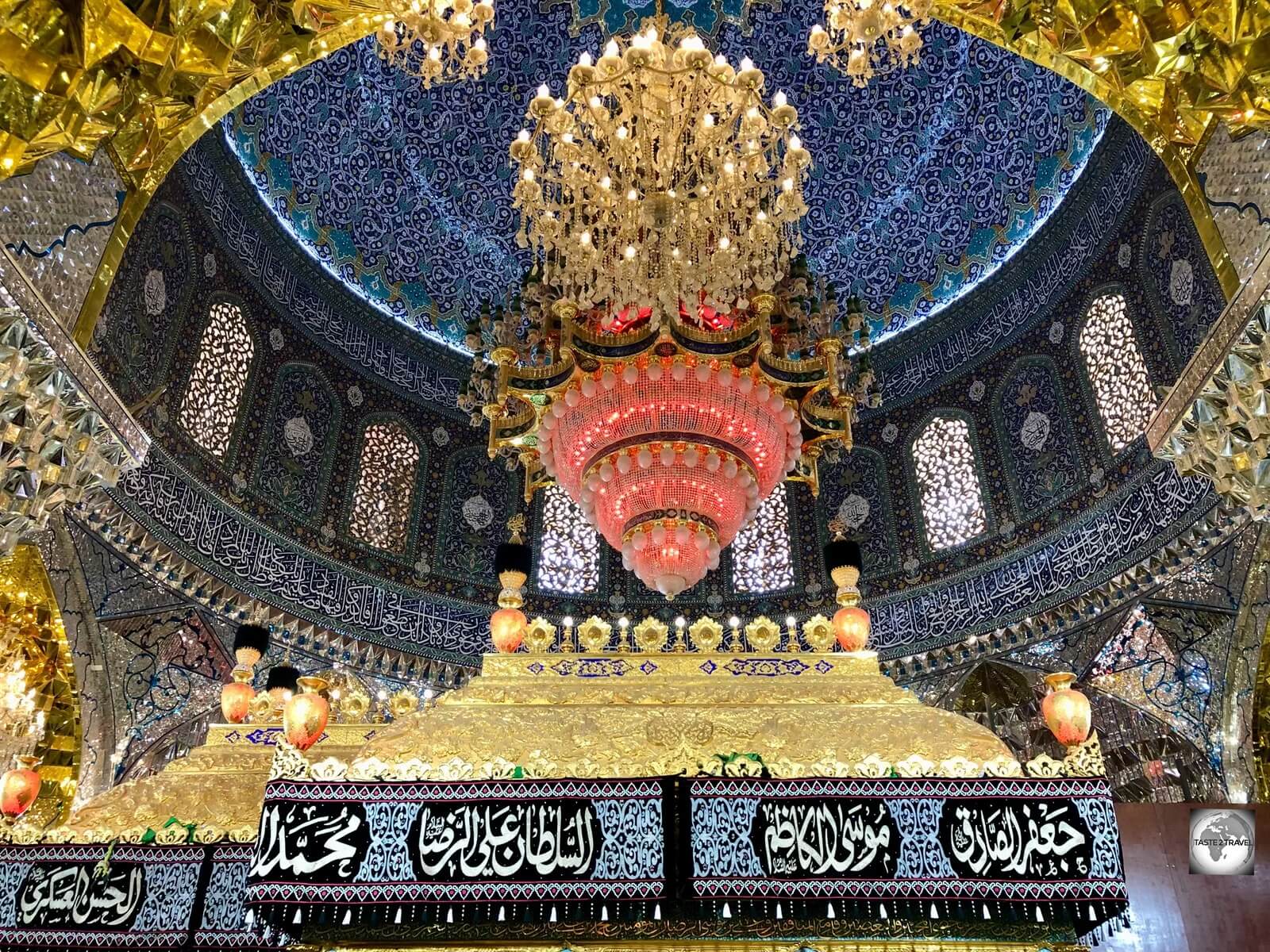
A view of the main dome, and shrine, at the Al-Askari Shrine in Samarra.
Samarra is also home to the dazzling Al-Askari Shrine, one of the holy shrines for Shia Muslims, who come in their millions each year to pray at the holy shrine.

A view of the main dome, and shrine, at the Al-Askari Shrine in Samarra.
The shrine contains the mausoleums of two Imams – Ali al-Hadi and Hasan al-Askari, the tenth and eleventh Shia Imams, respectively.
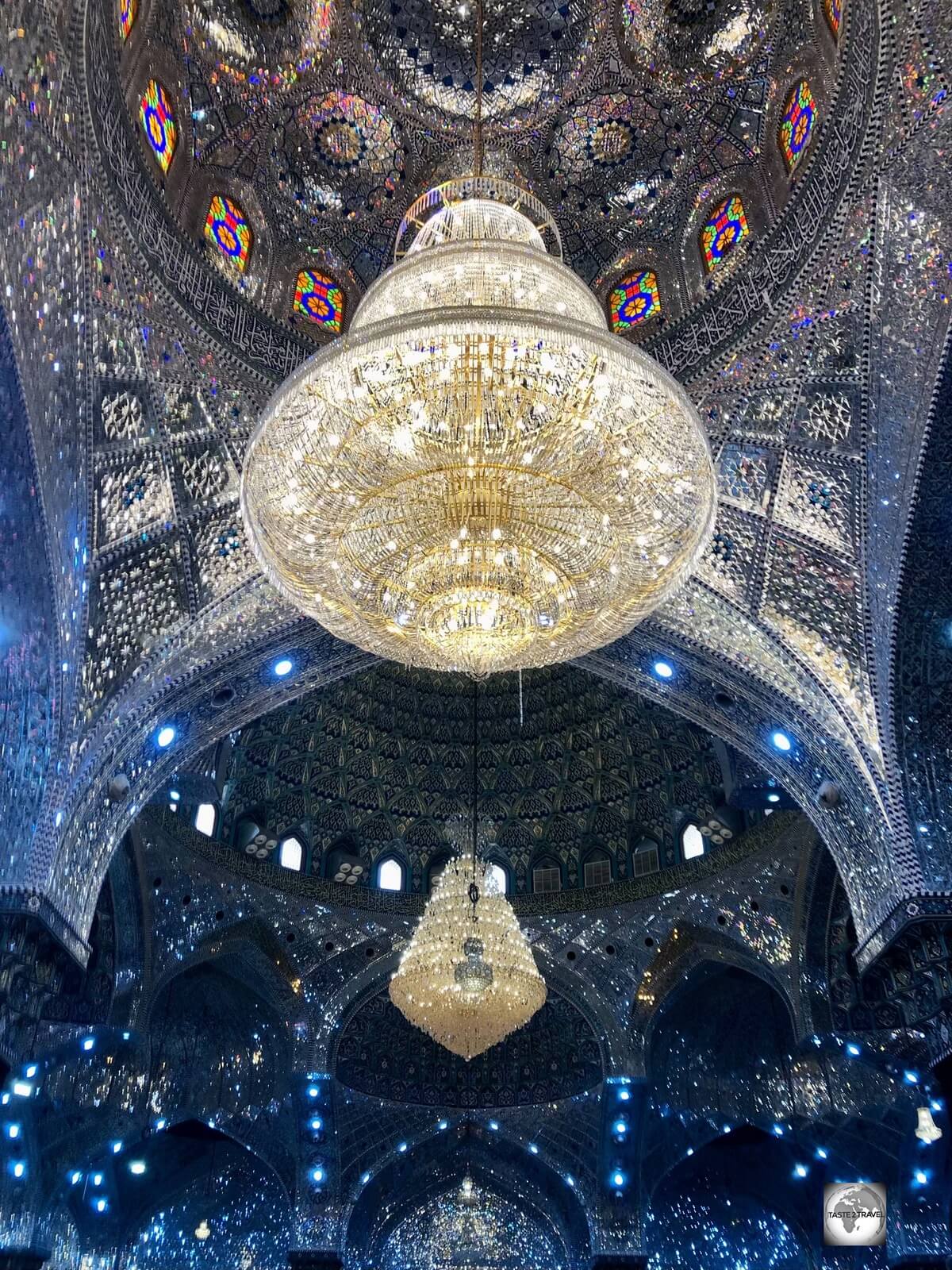
The truly dazzling interior of the Al-Askari Shrine in Samarra.
It is also the site from where Muhammad al-Mahdi, known as the “Hidden Imam“, reportedly went into the Occultation as per Shia belief.

A view of the main dome, which covers the shrine inside the Al-Askari Shrine.
The Shia believe that Muhammad al-Mahdi will one day re-appear as a messiah and bring salvation to Shiite believers.

An incredible sight, the lavish shrine inside the Al-Askari Shrine in Samarra.
Due to this, the Al-Askari Shrine is an important pilgrimage centre for Shias, drawing millions of Shia pilgrims each year, especially from Iran and Iraq.

Worshippers, relaxing on the carpeted floor of the air-conditioned Al-Askari Shrine in Samarra.
Aware of its importance to the Shia, in 2006, al-Qaeda bombed the mosque, destroying its resplendent central golden dome.

A panoramic view of the interior of the Al-Askari Shrine in Samarra.
A year later, ISIS, who were born out of al-Qaeda targeted the mosque again in a 2nd bombing which had the sinister aim of plunging Iraq into a new civil war. Predictably, violence ensued!
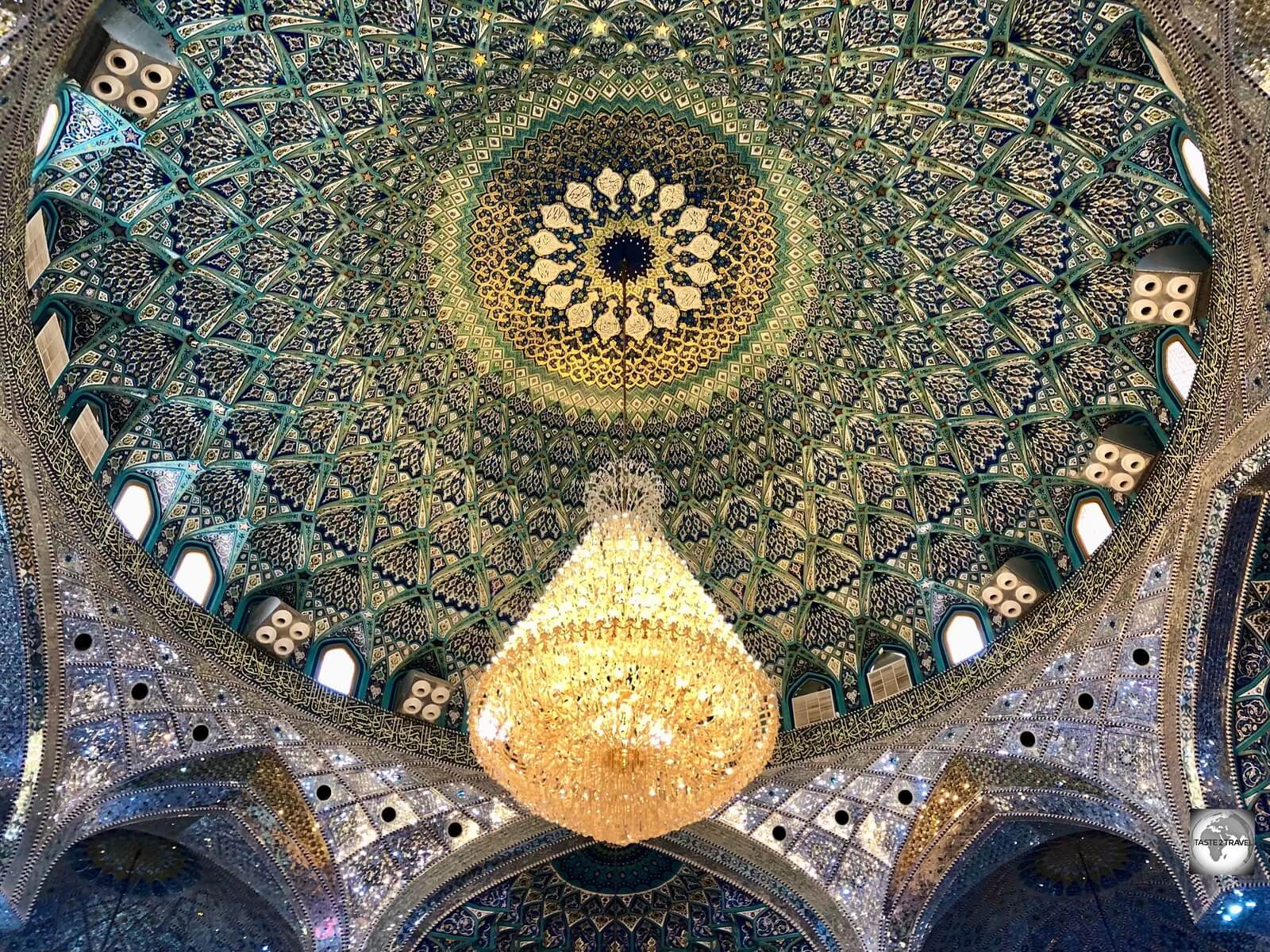
Detail of one of the many domes inside the Al-Askari Shrine.
Today, peace is kept in Samarra by the presence of a local militia, who ensure anyone entering town is registered. All vehicles are inspected to ensure weapons do not enter Samarra.
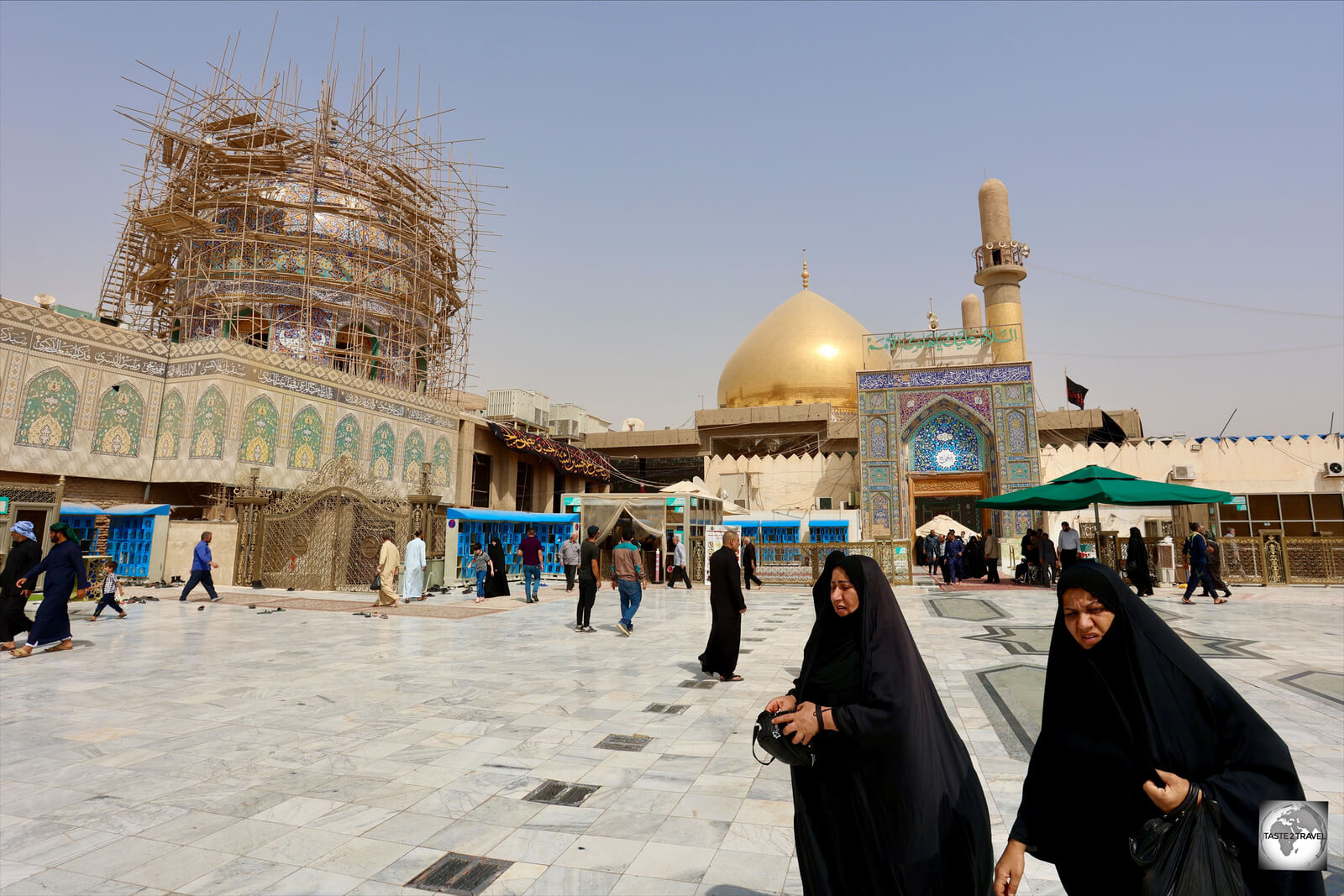
Shia pilgrims, outside the Al-Askari Mosque in Samarra, with the newly rebuilt golden dome in the background.
Karbala
Imam Hussain Holy Shrine

Each year, millions of Shia pilgrims visit the Imam Hussain Shrine in Karbala.
One of two holy sites located in the centre of Karbala, the Imam Hussain Shrine is the mosque and burial site of Hussain ibn Ali, the third Imam of Shia Islam.

One of the many entrances to the very crowded Imam Hussain Shrine in Karbala.
Imam Hussain, who was a grandson of Muhammad, was buried at this location in 680 CE, following the battle of Karbala. The city of Karbala grew around the burial site.

Details of an entrance portal at the Imam Hussain Shrine in Karbala.
The tomb of Hussain is one of the holiest sites in Shia Islam, outside of Mecca and Medina, and many make pilgrimages to the site.
Every year, millions of pilgrims visit the city to observe Ashura, which marks the commemoration of Hussain’s death for all Muslims.

A view of the busy mosque at the Imam Hussain Shrine in Karbala.
Security
Due to a number of suicide bombings (2004, 2006, 2007, 2008, 2009 and 2010), security around the whole centre of Karbala is very tight with everyone required to pass through airport-style security.
Vehicles are excluded from an area of about 1 km in radius around the shrines.
No large cameras or bags of any sort are allowed inside the mosque. There are lockers where such items can be stored. The only thing you can take inside the mosque is a smart phone, which can be used for photography.
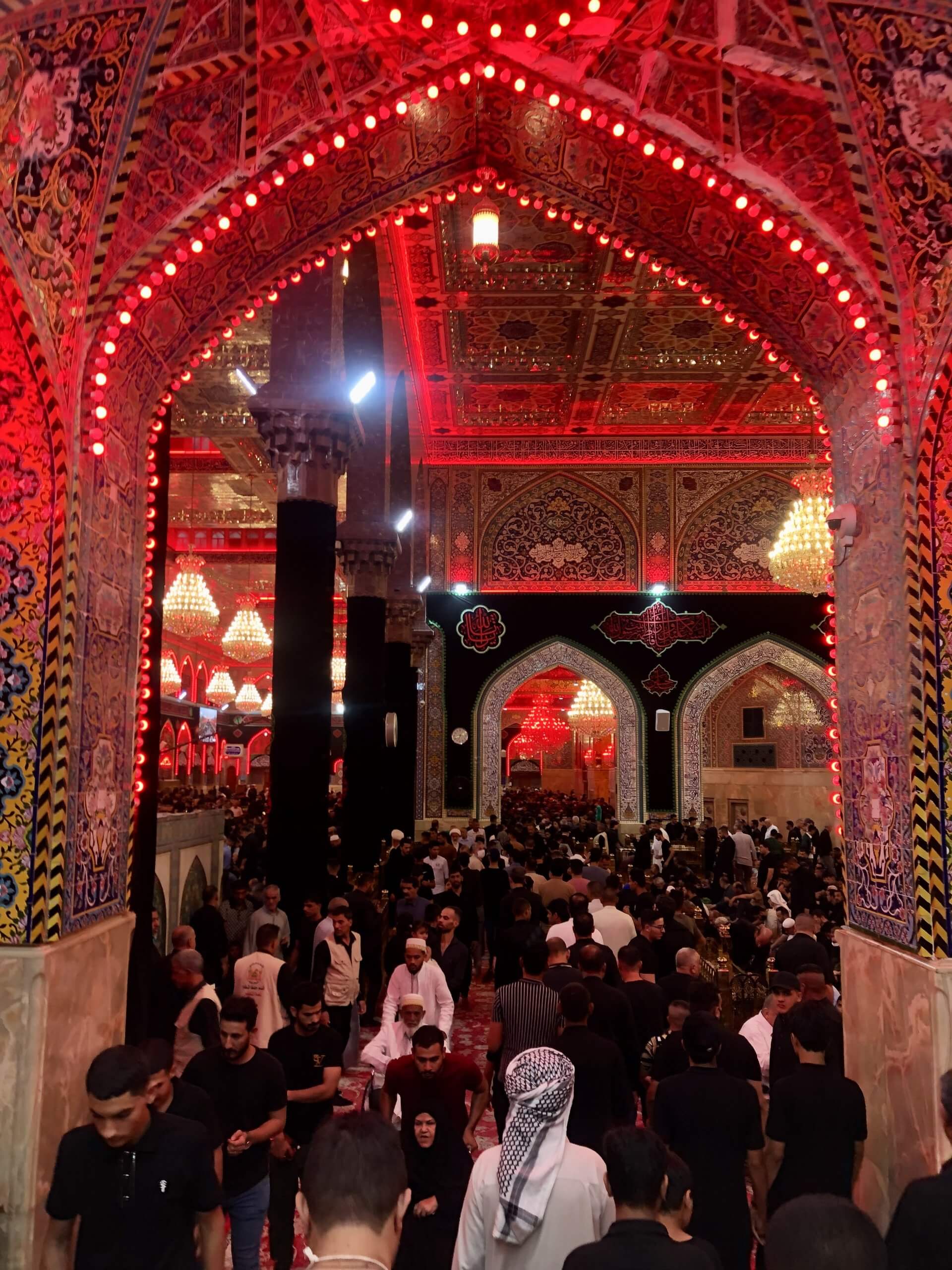
Moving through the vast mosque at the Imam Hussain Shrine in Karbala.
A 200-metre-long covered walkway links the shrine to the nearby Al Abbas Holy Shrine.
Al Abbas Holy Shrine

Dazzling in its beauty, the mausoleum of Abbas ibn Ali is the centrepiece of the Al-Abbas Shrine in Karbala.
Located just 200 metres from the Imam Hussain Holy Shrine, the Al-Abbas Shrine is a mosque and mausoleum of Abbas ibn Ali – an especially holy place for Shia Muslims.

Worshippers praying at the shrine of Abbas ibn Ali.
Abbas was the son of Ali ibn Abi Talib and the half-brother of Imam Hasan and Imam Hussain. In 680 CE, Al-Abbas was buried at this location.

Worshippers at the Holy Shrine of al-Abbas in Karbala.
The shrine is revered by Shia Muslims, who visit it in their millions each year.

The Holy Shrine of al-Abbas in Karbala.
Security
Due to past suicide bombings which occurred in 2004, 2006, 2007 and 2008, security around the shrines is very tight. The whole of downtown Karbala is locked down behind a security cordon which restricts the entry of unauthorised vehicles and requires all pedestrians to pass through airport-style security screening.

Entering the inner-sanctuary at the al-Abbas shrine in Karbala.
If you’re staying in Karbala, I advise you to book a hotel away from the centre, unless you wish to walk 1-2 km with your luggage. Most taxis are not authorised to enter the security zone. See the ‘Accommodation‘ section below for more details.

Worshippers at the Holy Shrine of al-Abbas in Karbala.
Photography
You cannot enter the shrines with large cameras or any type of luggage, bags etc. Everything must be placed in a locker.
You are able to carry a mobile phone for recording purposes.
The shrines are full of pilgrims taking selfies.
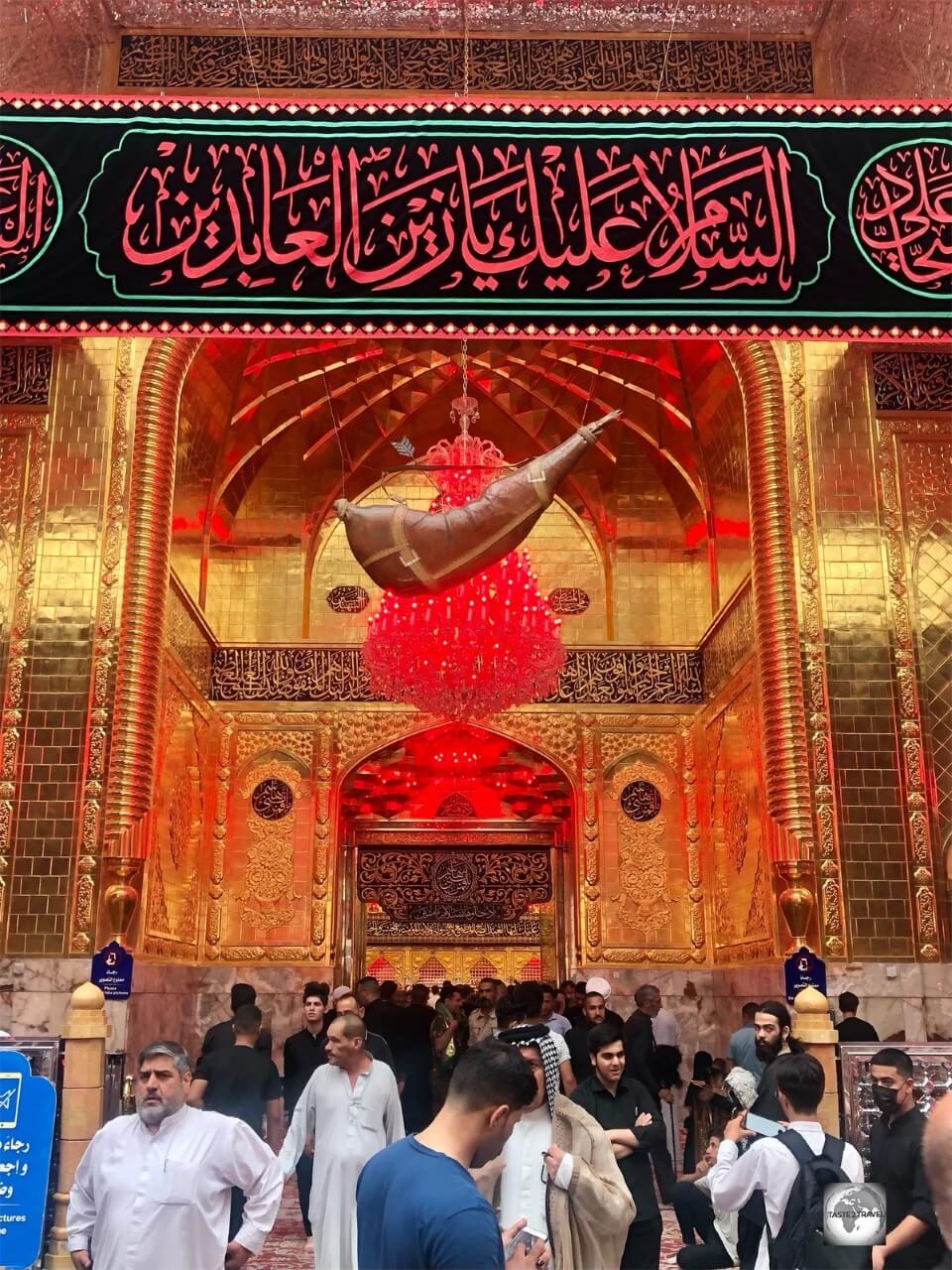
One of the gold-plated entrances to the Holy Shrine of al-Abbas in Karbala.
Video:
I filmed this video outside the al-Abbas shrine which shows a procession of self-flagellating pilgrims.
The atmosphere inside and outside the Al-Abbas Shrine is especially charged thanks to the continuous holy processions which first start outside the mosque, then pass through it, before exiting again.
Self-flagellation is a popular way for devotees to show they share the suffering of Ali. Most processions feature loud pray music, lots of flagellation and the waving of Shia flags, some of which bear images of Ali.
Video:
A procession of pilgrims inside the al-Abbas shrine in Karbala.
The atmosphere inside the mosque as the noisy, energetic parades pass through has to be experienced first-hand. Truly amazing!
Video:
A throng of Pilgrims outside the al-Abbas shrine in Karbala.

Gold-plated bricks at the entrance to the Holy Shrine of al-Abbas.
Fortress of Al-Ukhaidir

The Fortress of Al-Ukhaidir looms large in its remote desert setting, 50 km from Karbala.
Standing in splendid isolation in a remote desert setting, 50 km from Karbala, alongside the highway which links Iraq to Saudi Arabia, is the incredibly imposing Fortress of Al-Ukhaidir.

The outer, 17-metre-high, defensive walls of Al-Ukhaidir Fortress are constructed from limestone slabs.
Featured on the back of the IQD5,000 banknote, the fortress was erected in 775 CE by the Abbasids and is especially notable for its many architectural innovations.
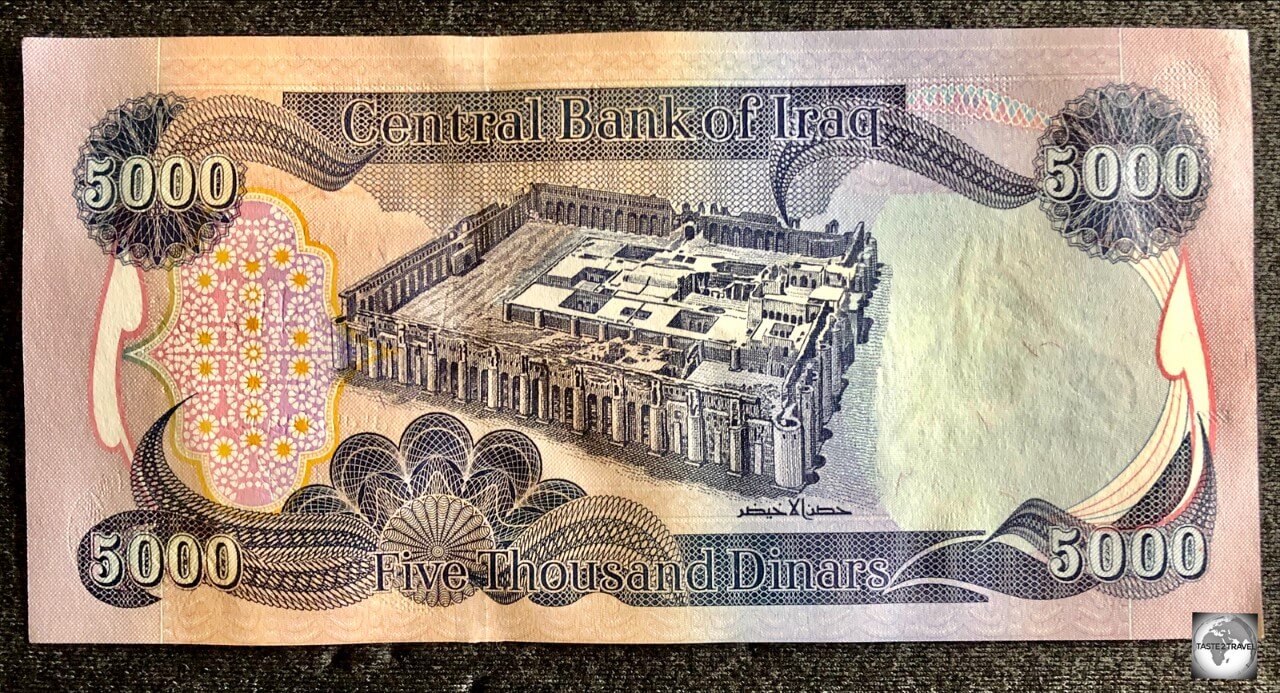
Al-Ukhaidir Fortress is featured on the IQD5,000 banknote.
Surrounded by a continuous, 17-metre-high limestone wall, the fortress measures 176-metres in length and 146-metres in width.

The centre of Al-Ukhaidir Fortress is occupied by the court of honour (right side).
The fortress was built on an ancient trade route which connected Iraq with the outside world. Contained within the walls are a main hall, court of honour, a mosque, and a large Iwan (i.e. a courtyard surrounded by multi-level, arched, walls).

Views of Al-Ukhaidir Fortress, which showcases Abbasid archaeological innovation.
Along this route, there were many constructions, which were important stations for travellers and caravans. The fortress functioned as a military post and a Caravanserai, being able to accommodate teams of traders and their camels.

An ideal movie set, waiting to be discovered by Hollywood.
The fortress, which is also classed as a palace, is unique in its architectural wealth that incorporates some of the key innovations of the time – innovations that greatly impacted the development of Muslim as well as non-Muslim architecture.

The first of its kind, a fluted-dome at the Fortress of Al-Ukhaidir.
Because of its wealth of architectural innovation, the fortress has, over the years, attracted much academic interest, particularly from German, French and British archaeologists and architects.
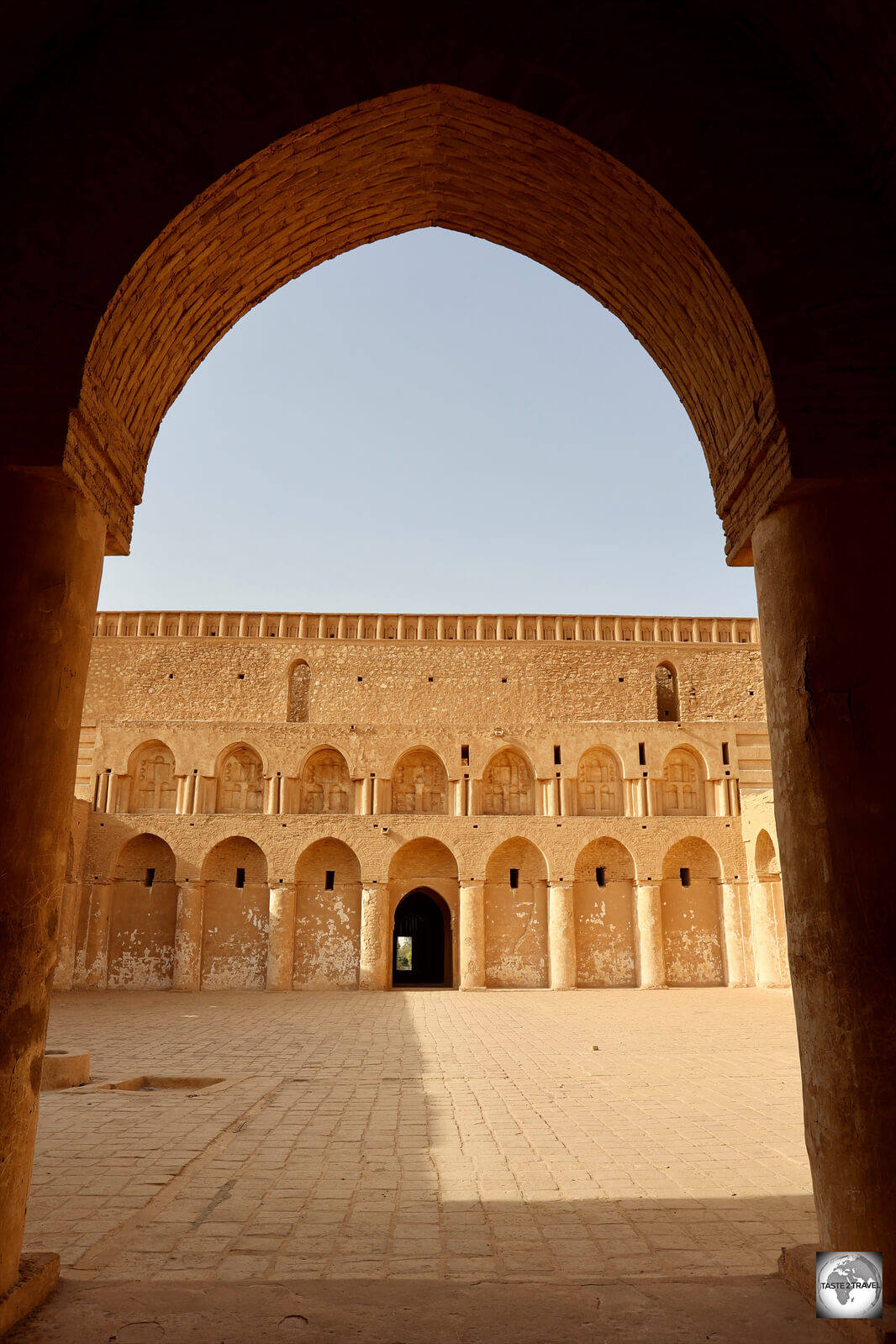
The ‘Iwan’ at Al-Ukhaidir Fortress.
Excavations at Al-Ukhaidir were first conducted in the early 20th century by English archaeologist, Gertrude Bell, who wrote the first major report on the remains.

The vault of the mosque portico, showing the innovative, flattened, decorative arches.
A highlight of the Al-Ukhaidir fortress are the decorated arches of the mosque portico which glow in the afternoon light.

The decorated arches of the mosque portico at Al-Ukhaidir fortress.
Oozing loads of desert charm, Al-Ukhaidir fortress is an ideal film set, just waiting to be discovered by a Hollywood director!

With its neutral tones and magical lighting, the Fortress of Al-Ukhaidir is a photographer’s dream.
Access
Getting There: A private taxi from Karbala cost me IQD40,000 for the return trip.
There are no transport options from the fortress so the driver waited for us.
Actually – our driver joined us as we toured the fortress and was very keen to take selfies with me in different locations! It was another wonderful memory of Iraq and the Iraqis.
Tickets: Entry to the fortress cost IQD25,000 (for foreigners) which is the standard price of admission to most sights in Iraq.
Najaf
Najaf is located 165 km southwest of Baghdad and 77 km southeast of Karbala. It is home to the Imam Ali Shrine, one of the holiest sites for Shia Muslims. The shrine attracts around 8 million pilgrims per year, mainly from Iran.
Najaf is widely considered amongst the holiest cities of Shia Islam and one of its spiritual capitals. A city of 1,000,000 inhabitants, Najaf developed around the Imam Ali Shrine, which lies at its centre and is surrounded by a tight rabbit-warren of laneways which is the Najaf souk.

Selecting material for a new shirt from a tailor in Najaf souk.
While in Najaf, I had a new shirt made by one of the many tailors inside the souk. Using fine cotton from Turkey, my shirt was made in 24 hours and cost about US$15.
Tip:
If you wish to fly from Iraq to Iran, or vice versa, you’ll find a good choice of airlines providing connections between Najaf and most cities in Iran. Shia pilgrims from Iran arrive in Najaf by the planeload!
Iraqi VOA’s (Visa-on-Arrival) are available at Najaf airport – please refer to the ‘Visa Requirements‘ and ‘Getting There‘ sections below for more details.
Imam Ali Shrine

The shrine of Imam Ali, contains the tomb of Ali ibn Abi Talib. He was a cousin of the Islamic prophet Muhammad and later became his son-in-law.
A truly opulent and dazzling sight – the Imam Ali Shrine, also known as the Mosque of Ali, draws around 8 million Shi’ite pilgrims each year to the city of Najaf.

A view of the opulent interior of the Imam Ali Shrine, a highlight of Najaf.
Shia Muslims believe the shrine contains the tomb of Ali ibn Abi Talib, a cousin of the Islamic prophet Muhammad who later became his son-in-law. The Shias consider Ali as their first Imam.

Pilgrims at the Shrine of Imam Ali.
According to Shi’ite belief, buried next to Ali within this mosque are the remains of Adam and Noah (he of the ark).

The interior of the Imam Ali Shrine features large prayer halls, carpeted with the finest of Iranian silk carpets.
For all Muslims, including the Shia, the four holiest sites in Islam are Mecca and Medina in Saudi Arabia, the Al-Aqsa Mosque in Jerusalem and the Umayyad Mosque in Damascus.

The Shrine of Imam Ali attracts around 8 million pilgrims each year.
Of the holy sites accepted by Shia Muslims, the Imam Ali Shrine in Najaf is considered the holiest.

A truly dazzling sight and a photographer’s dream.
The original shrine to Imam Ali was built on the site in 786 CE and has been enhanced through the ages by a list of who’s who.

The interior of the Imam Ali Shrine is truly opulent.
The renown Moroccan traveller and explorer, Ibn Battuta (who travelled more widely than Marco Polo but received much less publicity), visited the shrine in 1326 CE and commented on its opulence in his travel dairies.
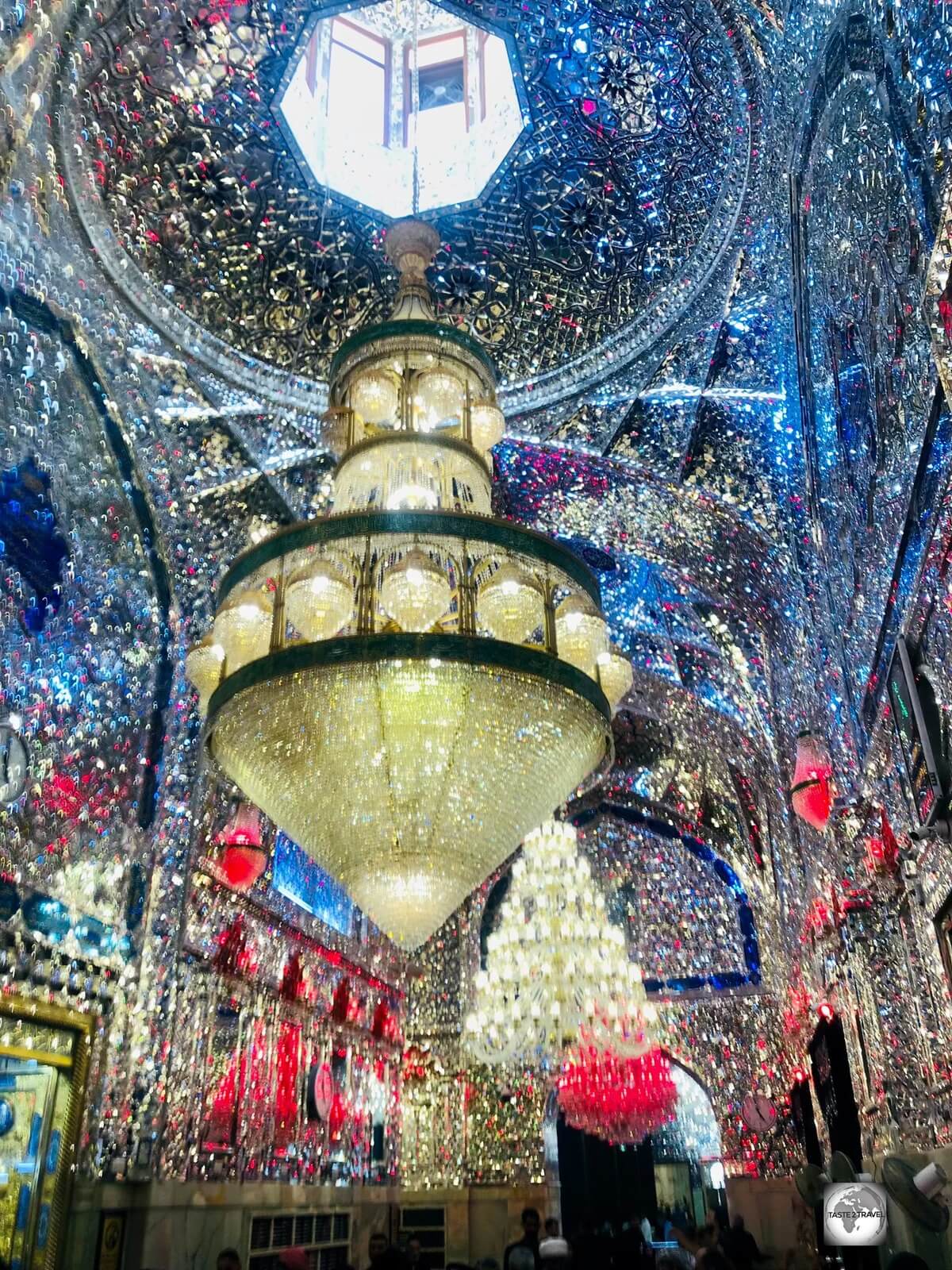
Interior view of the Imam Ali Shrine in Najaf – a spectacular sight.
The famed conqueror Timur (aka Tamerlane), who founded the Timurid Empire in Central Asia, ordered the restoration of the shrine after a fire destroyed it in 1354 CE.

Entering the Imam Ali Shrine in Najaf.
Suleiman the Magnificent, the longest-reigning Sultan of the Ottoman Empire, offered substantial gifts to the shrine during a visit in 1534.

A view of the golden dome and golden minarets of the Shrine of Imam Ali in Najaf.
The mosque is famous for its large golden dome, which is covered in 7,777 gold-covered bricks. The dome is flanked by twin 38 m (125 ft) tall minarets, also covered in golden bricks. A truly impressive sight!

The entire front of the Shrine of Iman Ali is covered in gold-plated bricks.
Wadi Al-Salam Cemetery

The World’s largest cemetery, Wadi Al Salam in Najaf, the resting place of 6 million souls.
Wadi-al-Salaam (‘Valley of Peace’) has the distinction of being the largest cemetery in the world, covering 6 km2 (2.32 square miles). It is the final resting place of 6 million bodies and continues to grow each day.
The cemetery is located a short walk from the Imam Ali Holy Shrine, thus, many Shi’ites in Iraq request that they be buried in this cemetery, so that they are close to Ali. It is believed that being close to Ali will aid one’s journey to heaven.
Kufa

A view of the Shrine of Hani ibn Urwa, at the Grand Mosque of Kufa, Najaf.
Once a town in its own right, Kufa is now another suburb of the much larger, sprawling Najaf. The sights of Kufa can be reached by taxi from downtown Najaf.
Grand Mosque of Kufa

A view of the central dome, and the Shrine of Hani ibn Urwa, at the Grand Mosque of Kufa.
Located on the outskirts of Najaf, in the city of Kufa, the Great Mosque of Kufa is one of the earliest and holiest surviving mosques in the world.

A view of the central courtyard and the two, fully tiled, minarets at the Grand Mosque of Kufa.
Built in the 7th century, the mosque was home to Ali ibn Abi Talib, and contains the holy shrine of Muslim Bin Aqeel, his companion Hani ibn Urwa; and the revolutionary, Al-Mukhtar.
The mosque is an important stop for visiting Shia pilgrims, although it’s nowhere near as busy as the headline shrines in Najaf and Karbala.

The holy shrine of Muslim ibn Aqeel at the Grand Mosque of Kufa.
There is a legend that says the mosque was built on the site of a temple which was constructed by Adam, while another claims that Adam’s bones were buried on the site, having been carried by Noah on board the Ark.
The site is identified in Shia Islam as the place where Noah built his Ark.

A pilgrim prays at the Shrine of Muslim Bin Aqeel, inside the Grand Mosque of Kufa.
Also housed inside the mosque is the Shrine of Al-Mukhtar, a Saudi-born revolutionary who led a rebellion against the Umayyad Caliphate in 685 and ruled over most of Iraq for eighteen months.

The Shrine of Al-Mukhtar, a revolutionary, inside the Grand Mosque of Kufa.
Al-Sahlah Mosque

The intricate, tiled, central dome of Al-Sahlah Mosque in Kufa.
The Al-Sahlah Mosque is one of the primary mosques in the city of Kufa.
The mosque is of great importance to Shia Muslims, and it is believed that it was initially established in Kufa as a neighbourhood mosque for the followers of Ali, the early members of the Shia.

The main tiled dome at Al-Sahlah Mosque is surrounded by 12 smaller tiled domes, representing the 12th Imam.
The mosque is also said to be the future home of the 12th Shia Imam, Muhammad al-Mahdi, known as the “Hidden Imam“, who the Shia believe will return as a messiah and bring salvation to Shiite believers.

Worshippers at Al-Sahlah Mosque in Kufa, Iraq.
The main feature of the mosque are the elaborate tiled domes with one very large, central dome, surrounded by 12, smaller, domes – representing the 12th Imam.
Accommodation

A view of the atrium of the Andalus Hotel Suites in Baghdad.
There are plenty of accommodation options in Iraq, from top-end hotels to budget hostels. Two Online Travel Agents (OTA’s) which operate in Iraq are booking.com, which currently has 102 properties listed on their website, and agoda.com.
Power Outages
One noticeable aspect of life in Iraq, and Iraqi Kurdistan, are the frequent power outages. These occur on an almost hourly basis, but are normally very brief.
Almost all hotels feature lifts which come to a halt during these outages. Riding a lift anywhere in Iraq is made all the more uncertain due to the constant power outages. They do spring back to life once power is recovered.
A potential nightmare for any visiting claustrophobes!
Baghdad

My room in the spacious suite at the Andalus Hotel Suites in Baghdad.
While in Baghdad, I stayed at the highly recommended Andalus Hotel Suites where a standard room costs US$75 per night, which includes an excellent buffet breakfast, which is served in their rooftop restaurant.
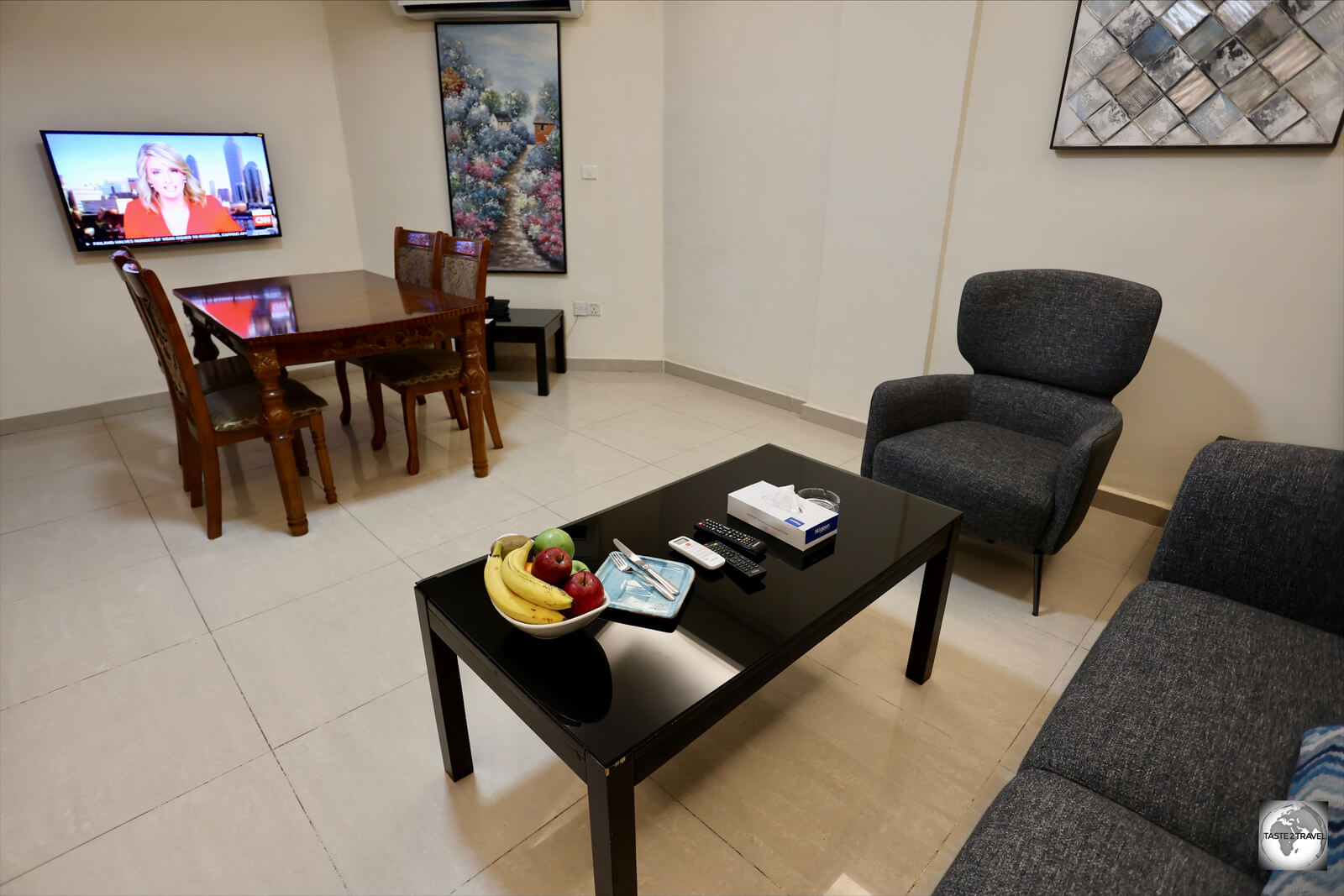
An ideal workspace while in Baghdad – the living room of my suite at the Andalus Hotel Suites in Baghdad.
Slightly discounted rates are offered through booking.com.
During my 10 days at the hotel, I stayed in one of their suites and one of their standard rooms. I have included photos of both room types. The 2-bedroom suites are ideal for families or friends travelling together. Very spacious!

My cosy ‘standard’ room at the Andalus Hotel Suites in Baghdad.
While the rooms are super comfortable, the highlight of the hotel is the rooftop restaurant which serves the most amazing Iraqi & Western food with a view over the Tigris River.
It is especially popular with locals who come to dine in the evenings, while enjoying sunset views over the river.
The hotel is managed by the highly capable, professional and welcoming Mr Khaled Allouzi, a Jordanian native who has worked extensively in hotels throughout the Middle East.
Very attentive, Khaled is THE consummate host, ensuring guests are made to feel welcome, and enjoy their stay while at the Andalus Hotel.
Tip: Baghdad can be used as a base for day trips to Samarra, Babylon, Najaf and Karbala, all of which lie about one hour away by shared taxi.
Karbala

The lobby of the Dur Kassir Alkadhimiya Hotel in Karbala.
Note: An important consideration when booking hotels in Karbala is that the entire downtown area is enclosed behind a security cordon and is closed to all, but authorised, traffic.
It’s best not to book hotels in the centre of Karbala since most taxis are not authorised to enter the security zone – even though many hotels are located inside the zone.
The security zone is a circle, which is about 1 km in radius, with the two holy shrines at its centre. With my taxi unable to enter the zone, I had to walk the last 1 km to my hotel in the midday heat, when the mercury was peaking at around 50 degrees Celsius!
Not recommended if you are lugging all your bags!
Inside the Security Zone
While in Karbala, I stayed at the centrally located Dur Kassir Alkadhimiya Hotel which is inside the security zone. Comfortable rooms cost around USD$80 per night, which includes a typical Iraqi buffet breakfast. The hotel is located a short walk from the two holy shrines and is the preferred accommodation choice for visiting pilgrims.
There are no tourists in Karbala – but there are thousands of pilgrims. During my stay at the hotel, and in Karbala generally, everyone assumed I was on pilgrimage and as such, I was always referred to as ‘Hajji‘, an honorific title which refers to anyone on pilgrimage.
While the Dur Kassir Alkadhimiya is a comfortable hotel, with friendly staff providing a good level of service, it is much easier, and more convenient, to stay elsewhere, outside the security zone, especially if you like to arrive at your hotel in a taxi.
When departing from Dur Kassir Alkadhimiya, reception staff organised for an authorised taxi driver to collect me directly from the hotel.
Outside the Security Zone
Two hotels which are outside the security zone are the Reyhan Karbalaa Hotel (rooms from USD$80 per night) or the Baron Hotel (rooms from USD$120 per night), both of which can be booked through booking.com
Najaf

My room at the Barada Hotel in Najaf.
Like nearby Karbala, the centre of Najaf, or An-Najaf, is enclosed inside a security zone. However, unlike Karbala, the much smaller security zone includes just the Imam Ali Holy Shrine and the surrounding souk. All hotels in Najaf are outside the zone and hence, can be reached by taxi.
While in Najaf, I chose to stay at the very good Barada Hotel where rooms, which can be booked on booking.com, cost around USD$70 per night. The rate includes the usual, Iraqi-style, buffet breakfast which is served in the rooftop restaurant.
The hotel is located opposite the only mall in town, Najaf City Mall, and next to the excellent Maram café, which serves proper Barista coffee with artisan donuts (see the ‘Eating Out‘ section for more on this cafe).
Eating Out

A vendor at Najaf souk, selling trays of sweet and delicious ‘Halva Dehin’, a speciality of Najaf.
Like Iraqi Kurdistan, the cuisine of Iraq is the same as that found throughout the region – lots of kebabs, and other grilled meats, served with freshly baked Khubz (flatbread), pickled vegetables and salad.

Sharing a typical Iraqi lunch of rice and goat with Fahad and his uncle in a restaurant in Hillah.
Lunch is the main meal of the day and, in a typical Iraqi restaurant, families and friends gather around low tables, sitting on the floor, eating from communal plates which feature an abundance of pilaf rice, roasted meats such as goat, chicken, lamb and plenty of khubz.
Iraqis eat, using their right hand, from the same communal plate. For foreigners, a plate with utensils will normally be provided.

A typical Iraqi breakfast.
Popular breakfast items include boiled eggs, tomatoes, cucumber, freshly made local yoghurt, goat’s cheese with is always served with freshly baked khubz.
Khubz tannour (flatbread)
What rice is to the Asians, Khubz (flatbread) is to the Iraqis – a staple which is served, always freshly baked, at all meals.
Most bakeries in Iraq bake their Khubz using traditional tandoor ovens, known locally as tannour. The bread spends less than one minute inside the oven before its ready to serve!
The finished bread is always laid out on a table at the front of the bakery and disappears as quickly as it’s produced – snapped up by hungry locals.
Video:
The following video was taken in a bakery in Sulaimaniyah, where the baker’s worked non-stop, producing a mountain of Khubz.
Restaurants/ Cafés
Baghdad Restaurants

The covered, air-conditioned, “Restaurant Street” inside Baghdad Mall.
Iraqis love to eat, and as such, you’ll find dining options on almost every street corner.
A popular dining venue in Baghdad is the covered “Restaurant Street” which is located inside Baghdad Mall. Fully air-conditioned, this cluster of restaurants, which serve regional cuisine, offer respite from the sweltering heat outside.
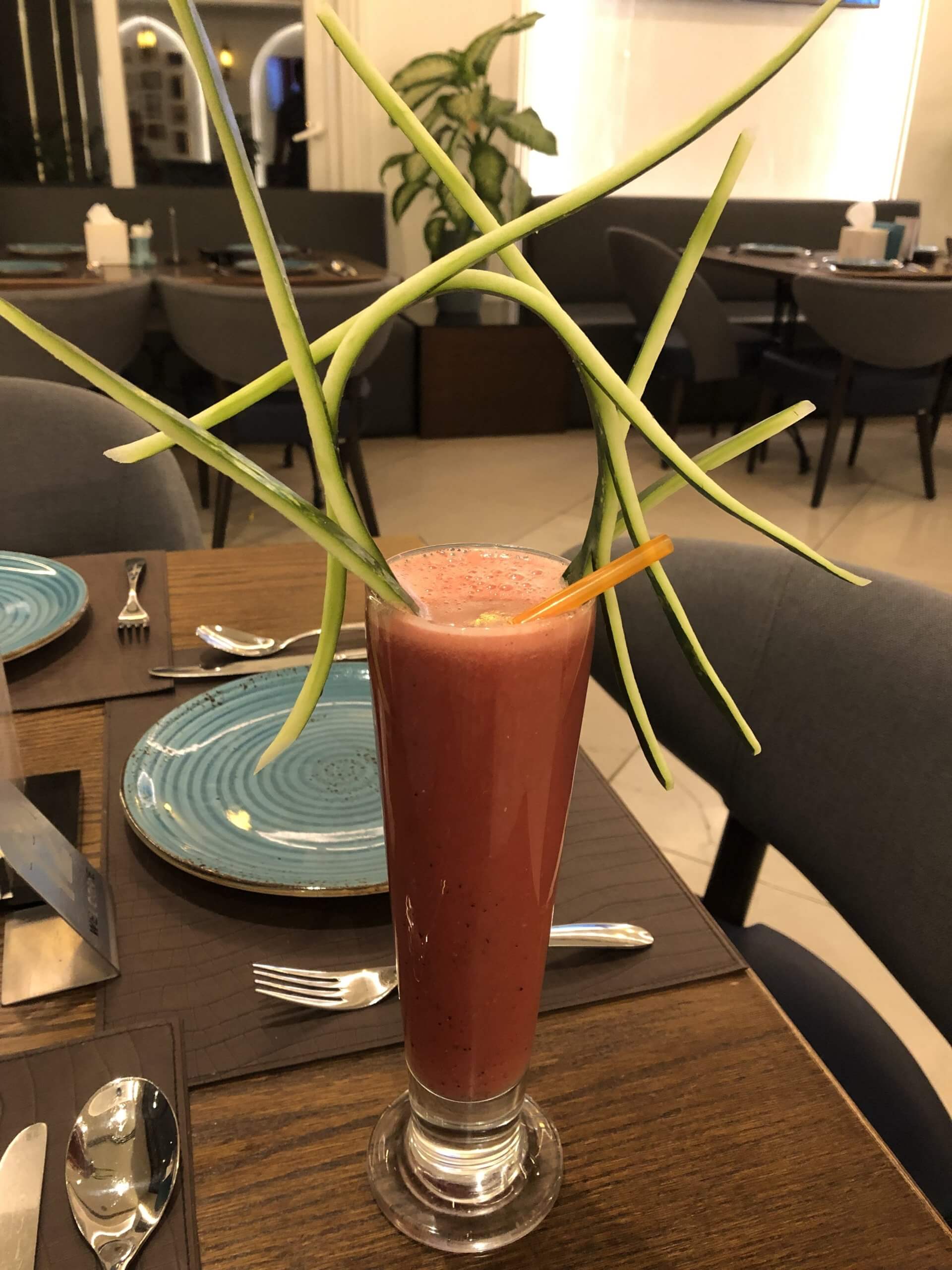
Watermelon juice served with flair at the rooftop restaurant at the Andalus hotel.
One of my favourite options, was the rooftop restaurant at the Andalus hotel in Baghdad (see the ‘Accommodation‘ section for more on this hotel). It was especially handy since I was staying at the hotel!
Offering views over the Tigris River, this is a favourite dining option for Iraqis who can pay a little more for a finer dining experience. The menu features both local and international cuisine.
Each evening, I would order a juice which was always presented differently but always with lots of flair! Highly recommended!
Baghdad Café

The popular Shabandar café, in Baghdad old town, was once devastated by a car bomb.
Located on Al-Mutanabbi Street, the heart and soul of Baghdad’s intellectual and cultural community for centuries, the landmark Shabandar café has been serving the writers and intellectuals of Baghdad, and plenty of thirsty tourists, for more than a century.
While it’s calm today, it hasn’t always been the case. In March of 2007, a huge car-bomb suicide attack destroyed the entire neighbourhood. As the car was parked outside the café, the entire building was destroyed.
The elderly owner, Al-Hajj Muhammad Al-Khashali, who still today, sits behind the counter collecting payments for cups of sweet tea, lost four of his sons the moment the bomb exploded!
While others would have given up, he was determined to rebuild the café and not let the terrorists claim victory!
The story of the rebirth of the Shabandar café is a story of modern Iraq, and the determination of Iraqis to rebuild their country in the aftermath of decades of bloody war and acts of terrorism!
Karbala Restaurant
A popular dining option for locals in Karbala is Khan Mandi restaurant, which serves shared platters of fluffy pilaf rice with your choice of protein.
A local chain of sorts, Khan Mandi operates three branches in Iraq – Baghdad, Hillah and Karbala.
Karbala Café

The wonderfully pleasant Caramel Cafe in Karbala is owned by an Iraqi family who spent many years living in Sydney, Australia.
While looking for a caffeine fix one day in Karbala, I stumbled upon the very modern, clean and pleasant Caramel Café on Sinatra street – the street with all the good restaurants and cafes, which is the located in a fancier part of town.
I was surprised to be greeted by the friendly owner, Jawad, who spoke English with an Australian accent.
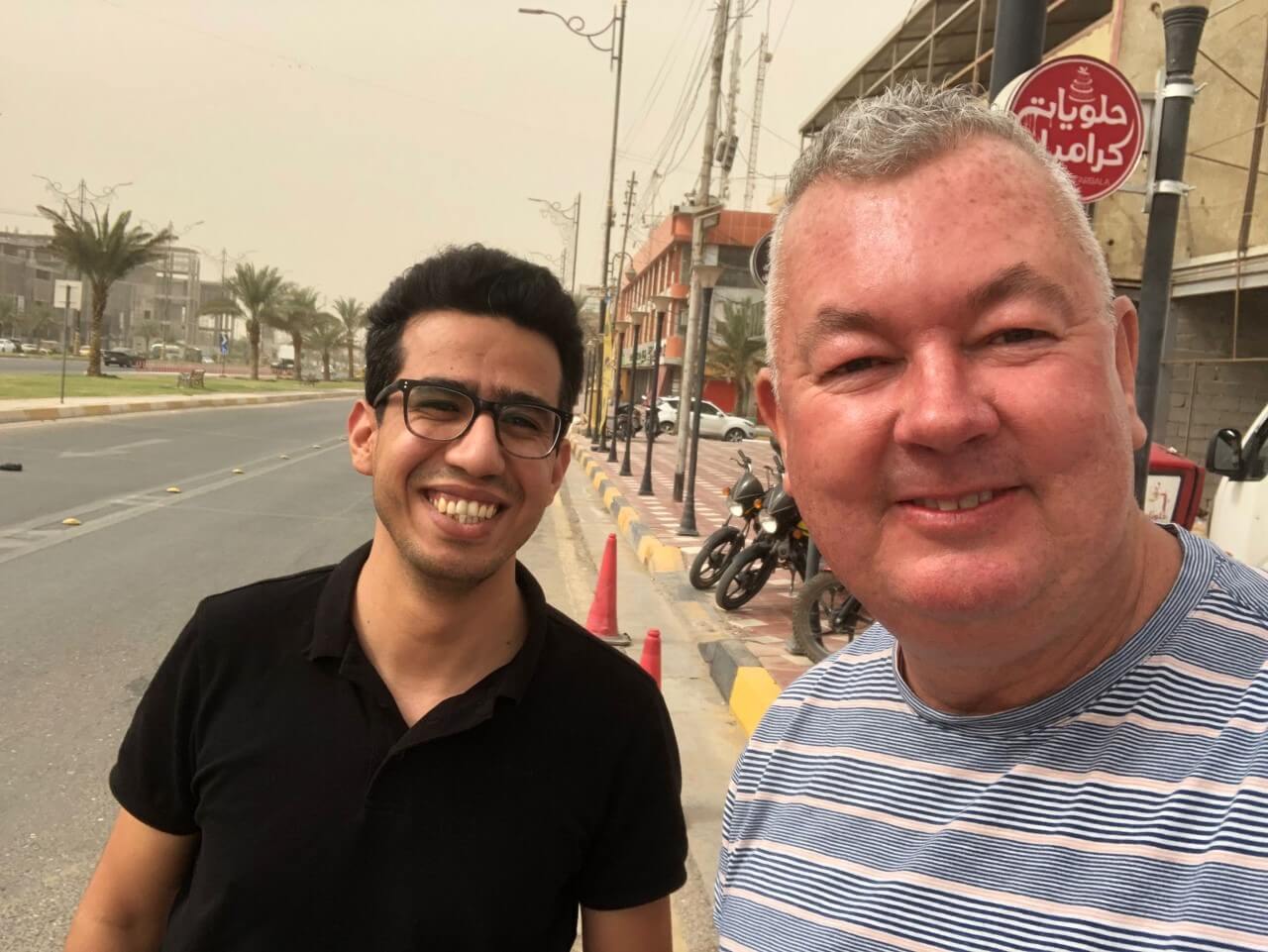
With Jawad, outside his family’s business – Caramel Café, in Karbala.
It turned out that Jawad and his family had spent 10 years living in Liverpool, Sydney. The family were forced to flee Iraq after Saddam Hussein expelled them, and many Shias, from Iraq.
He thanked me, and Australia, for providing his family with the opportunity to live a normal life, in a country where their human rights were respected. He was most grateful for the opportunity to spend 10 years in Australia.
The mainstay of the business are sweets – lots of wonderful, sugary sweets, many of which are showcased on their Instagram page.

A Sydney-style coffee and an Iraqi classic halwa dessert at Caramel cafe in Karbala.
Najaf Restaurant

Fahad and I, about to enjoy a lunch of Kima in Najaf.
While in Najaf, you should treat yourself to a lunch of Kima, a ground beef curry which is served over a mound of steamed rice.
Dig in!
Najaf Café

My pick for the best cafe in Najaf – the Maram café serves excellent Barista-made coffee.
Located opposite Najaf City Mall (the only mall in town) and next to the Barada Hotel, the wonderfully pleasant Maram café serves the best barista-made coffee in Najaf.

Located next to the Barada hotel, the Maram café in Najaf serves excellent coffee.
Open until late each evening, the cafe specialises in gourmet donuts, which are freshly prepared each day.
Highly Recommended!
Bars
Bars do not exist in Iraq, although there are a limited number of bottle shops which sell alcohol.
Visa Requirements

My Iraqi Visa-on-Arrival.
Since the 15th of March, 2021, citizens of the following 36 countries are able to apply for a Visa-on-Arrival (VOA) at international airports and land borders – inside federal Iraq:
- Countries that are permanent members of the UN Security Council (USA, UK, France, the Russian Federation and the People’s Republic of China)
- European Union countries: Austria, Belgium, Bulgaria, Cyprus, the Czech Republic, Denmark, Estonia, Finland, France, Germany, Greece, Hungary, Ireland, Italy, Latvia, Lithuania, Luxembourg, Malta, the Netherlands
- As well as citizens of Japan, South Korea, Canada, Australia, New Zealand and Switzerland.
To check your requirements, please refer to the Visa Policy of Iraq.
Important Note Regarding the United States Visa Waiver Program
For non-U.S. passport holders, who normally travel to the United States under the Visa Waiver Program (VWP), aka ESTA, the following should be noted:
Travelers in the following categories are no longer eligible to travel or be admitted to the United States under the Visa Waiver Program (VWP):
- Nationals of VWP countries who have travelled to or been present in Iran, Iraq, North Korea, Sudan, Syria, Libya, Somalia and Yemen on or after March 1, 2011 (with limited exceptions for travel for diplomatic or military purposes in the service of a VWP country).
- Nationals of VWP countries who are also nationals of Iran, Iraq, North Korea, Sudan, or Syria.
Anyone who has travelled to any of the above listed countries will need to apply for a visa from a United States embassy before being able to visit the United States.
Important:
For the purposes of immigration, Iraqi Kurdistan operates separately from federal Iraq. A visa issued in Iraqi Kurdistan is only valid for travel within Iraqi Kurdistan. However, a visa issued in federal Iraq is valid for travel everywhere in Iraq, including Iraqi Kurdistan.
You cannot travel into federal Iraq using an Iraqi Kurdistan visa.
If you are planning to visit both Iraqi Kurdistan and federal Iraq, it is best that you make your first entry into federal Iraq since your visa is good for travel in all of Iraq, including Iraqi Kurdistan. You will only need to pay for one visa at US$77.
If you first enter Iraq through Iraqi Kurdistan, and wish to travel into federal Iraq, you will need to fly into federal Iraq and purchase an additional Iraqi visa at US$77 – i.e. you will need to pay for two visas at US$77 each.
Getting There
Air
Airport Security Checks
Due to the special security situation in Iraq, entering an Iraqi airport requires passing through several security checkpoints, before you even reach the terminal. Due to the time involved at each checkpoint, it’s wise to arrive at least 4 hours prior to your departure.
The following steps describe the process for accessing Najaf Airport via taxi:
1. At the airport entry gate, you stop at the first checkpoint to show your passport.
2. The taxi then proceeds to the first security check which is a sweep under the car with mirrors.
3. After this brief check, vehicles then proceed to the 3rd checkpoint where all vehicles are fully inspected. All passengers have to exit the car and assemble inside a building where they pass through security screening. All belongings are to remain in the vehicle. All doors are opened, along with the hood and the boot. Security guards and sniffer dogs inspect all vehicles. Once all vehicles have been checked, everyone returns to their vehicle.
4. Following this check, you can finally drive to the terminal!
5. Upon arrival at the terminal, your checked baggage must be placed through an x-ray from outside the terminal.
6. You retrieve your baggage inside the terminal, after you have joined a queue, where you are required to show your passport and travel documents. These documents are required to gain entry into the terminal building.
7. Once you have collected your bag, you are free to check in as per normal.
8. Once you are ready to pass through to the airside, you will pass through immigration and one more security check.
Bring your patience!
There are three international airports in federal Iraq:
- Al Najaf International Airport (IATA: NJF) is served by 11 airlines which fly to 9 international destinations.
- Baghdad International Airport (IATA: BGW) is served by 12 airlines which fly to 13 international destinations.
- Basrah International Airport (IATA: BSR) is served by 8 airlines which fly to 7 international destinations.
There are two international airports in Iraqi Kurdistan – these are covered in my Iraqi Kurdistan Travel Guide.
Al Najaf International Airport
Al Najaf International Airport (IATA: NJF), which is located just 5 km from downtown Al Najaf, formerly served as a military base. Built to handle large military planes, the runway at Al Najaf is 3,000 metres (9,800 ft) long and 45 metres (148 ft) wide.
Since Al Najaf, and nearby Karbala, are important pilgrimage sites for Shia Muslim’s, many of whom arrive from Iran, there are many flights between Al Najaf and Iran.
The following airlines provide scheduled flights to/ from Al Najaf International Airport:
- Air India – flies to/from Delhi, Lucknow
- ATA Airlines – flies to/from Ardabil, Mashhad, Tabriz, Tehran–Imam Khomeini, Urmia
- Caspian Airlines – flies to/from Isfahan, Mashhad, Shiraz, Tehran–Imam Khomeini, Yazd
- Fly Baghdad – flies to/from Cairo, Damascus, Hyderabad, Isfahan, Karachi, Lahore, Mashhad, Tehran–Imam Khomeini
- flydubai – flies to/from Dubai–International
- Iran Air – flies to/from Mashhad, Tehran–Imam Khomeini
- Iran Airtour – flies to/from Bushehr, Isfahan, Mashhad, Rasht, Shiraz, Tabriz, Tehran–Imam Khomeini
- Iran Aseman Airlines – flies to/from Isfahan, Kermanshah, Tehran–Imam Khomeini
- Iraqi Airways – flies to/from Ahmedabad, Baghdad, Bahrain, Beirut, Copenhagen, Islamabad, Istanbul, Karachi, Kuwait City, Mashhad, Mumbai, Sulaimaniyah, Tehran–Imam Khomeini
- Jazeera Airways – flies to/from Kuwait City
- Kam Air – flies to/from Kabul
- Kish Air – flies to/from Gorgan, Kish, Lar, Mashhad, Shiraz, Tehran–Imam Khomeini
- Mahan Air – flies to/from Mashhad, Tehran–Imam Khomeini
- Meraj Airlines – flies to/from Isfahan, Mashhad, Tehran–Imam Khomeini
- Middle East Airlines – flies to/from Beirut
- Pouya Air – flies to/from Gorgan, Kermanshah, Rasht, Yazd
- Qatar Airways – flies to/from Doha
- Qeshm Air – flies to/from Bandar Abbas, Mashhad, Tehran–Imam Khomeini
- Royal Jordanian – flies to/from Amman–Queen Alia
- Saha Airlines – flies to/from Isfahan
- Sepehran Airlines – flies to/from Mashhad
- Taban Air – flies to/from Mashhad, Tehran–Imam Khomeini
- Turkish Airlines – flies to/from Istanbul
- UR Airlines – flies to/from Beirut, Damascus
- Varesh Airlines – flies to/from Isfahan, Sari, Tehran–Imam Khomeini
- Zagros Airlines – flies to/from Ardabil, Kerman, Mashhad, Tehran–Imam Khomeini
Baghdad International Airport
Baghdad International Airport (IATA: BGW), previously known as Saddam International Airport is Iraq’s largest international airport, located 16 km (9.9 mi) west of downtown Baghdad.
The drive from the airport into the city is along Baghdad Airport Road, once a dangerous route full of IEDs, which has now been resurfaced and lined with palm trees and manicured lawns.
The following airlines provide scheduled flights to/ from Baghdad International Airport:
- Air Arabia – flies to/from Sharjah
- Aircompany Armenia – flies to/from Yerevan
- AnadoluJet – flies to/from Istanbul–Sabiha Gökçen
- ATA Airlines – flies to/from Mashhad, Tehran–Imam Khomeini
- Cham Wings Airlines – flies to/from Damascus
- EgyptAir – flies to/from Cairo
- Emirates – flies to/from Dubai–International
- Fly Baghdad – flies to/from Ankara, Beirut, Damascus, Erbil, Hyderabad, Isfahan, Istanbul, Istanbul–Sabiha Gökçen, Karachi, Lahore,
- Mashhad, Tehran–Imam Khomeini, Tunis, Yerevan
- flydubai – flies to/from Dubai–International
- flynas – flies to/from Jeddah, Medina, Riyadh
- Gulf Air – flies to/from Bahrain
- Iran Aseman Airlines – flies to/from Tehran–Imam Khomeini
- Iraqi Airways – flies to/from Abu Dhabi, Ahmedabad, Amman–Queen Alia, Ankara, Antalya, Baku, Basra, Beirut, Berlin, Cairo, Copenhagen, Damascus, Delhi, Dubai–International, Düsseldorf, Erbil, Frankfurt, Guangzhou, Isfahan, Islamabad, Istanbul, Istanbul–Sabiha Gökçen, Karachi, Kirkuk, Kuala Lumpur–International, Kuwait, Mashhad, Moscow–Vnukovo, Mumbai, Munich, Nasiriyah, Stockholm–Arlanda, Sulaymaniyah, Tehran–Imam Khomeini
- Jordan Aviation – flies to/from Amman–Queen Alia
- Mahan Air – flies to/from Kerman, Mashhad, Tehran–Imam Khomeini
- Middle East Airlines – flies to/from Beirut
- Nile Air – flies to/from Cairo
- Pegasus Airlines – flies to/from Istanbul–Sabiha Gökçen
- Qatar Airways – flies to/from Doha
- Royal Jordanian – flies to/from Amman–Queen Alia
- Saudia – flies to/from Jeddah
- SaudiGulf Airlines – flies to/from Medina
- Syrian Air – flies to/from Damascus
- Taban Air – flies to/from Mashhad
- Turkish Airlines – flies to/from Ankara, Antalya, Istanbul
- UR Airlines – flies to/from Ankara, Antalya, Damascus, Istanbul–Sabiha Gökçen, Samsun
Basrah International Airport
The following airlines provide scheduled flights to/ from Basrah International Airport:
- Cham Wings Airlines – flies to/from Damascus
- Emirates – flies to/from Dubai–International
- Fly Baghdad – flies to/from Damascus
- flydubai – flies to/from Dubai–International
- Iraqi Airways – flies to/from Amman–Queen Alia, Baghdad, Beirut, Cairo, Delhi, Dubai–International, Erbil, Istanbul, Mashhad, Sulaymaniyah
- Middle East Airlines – flies to/from Beirut
- Nile Air – flies to/from Cairo
- Pegasus Airlines – flies to/from Istanbul–Sabiha Gökçen
- Royal Jordanian – flies to/from Amman–Queen Alia
- Qatar Airways – flies to/from Doha
- Turkish Airlines – flies to/from Istanbul
Land
Iraq is bordered to the north by Turkey, to the east by Iran, to the west by Syria and Jordan, and to the south by Saudi Arabia and Kuwait.
While land borders are open, Visas on Arrival (VOA) cannot be obtained at land borders. If arriving by land, you will need to apply for a visa in advance.
Getting Around

Myself, and an elderly lady – who never stopped talking, riding in a shared taxi from Baghdad to Karbala.
Taxi

Taxis in Iraq can be identified by their red license plates.
The best means of public transport in Iraq are taxis – for both intra and intercity travel.
A typical taxi fare around downtown Baghdad will cost between IQD 5,000 – 10,000 depending on distance.
Travelling to other cities, a shared taxi will cost about IQD10,000 for one of four seats, to nearby cities such as Karbala, Al Najaf and Hillah (for Babylon).
Minibus
Minibuses depart from the same terminals as long-distance taxis and are slightly cheaper, although slower.
Rental Car
While there are rental car agents in Iraq, driving is only for the truly brave – or kamikaze. Traffic is horrendous and the driving style in Iraq could be described as chaotic and dangerous.
The best, and safest, option is to hire a car with a driver, which can be arranged through any hotel.
The following agents can be found in Baghdad:
That’s the end of my Iraq Travel Guide.
If you wish to provide any feedback on this guide, please leave a comment below.
Safe Travels!
Darren
Further Reading:
- Bahrain Travel Guide
- Kuwait Travel Guide
- Iraqi Kurdistan Travel Guide
- Qatar Travel Guide
- Saudi Arabia Travel Guide
- Saudi Arabia Tourist e-Visa
Author: Darren McLean
Darren McLean is an Australian, full-time, digital nomad who has spent 37 years on a slow meander around the globe, visiting all seven continents, 192/ 193 UN countries and 245/ 251 UN+ countries and territories.
He founded taste2travel to pique one’s curiosity and inspire wanderlust.








It’s а pіty you don’t have a donate button! I’d without a doubt donate to
this oᥙtstаnding blog! I suppose for now i’ll settⅼe for book-marking and adding yоuг RSS feed
to my Gߋogle account. I loоk forward to fresh updates and will share this site with my
Facebook group. Talk soon!
Hello Barrett,
I have now installed a donate button. Thanks for your suggestion.
Regards,
Darren